Archive for the ‘Philip’s Nature Diary’ Category

It has been another week of sunny days and rainy nights. Last month the immediate area experienced almost 28 inches, (706 mm), of rain. That is approximately 1 inch per day. However, as to be expected, the pattern of precipitation was not that evenly spread. There were several nights with really heavy downpours which accounted for a third of the total. There were more nights when it rained hard but not in a deluge and then there were nights when there was no rain.
Atop Cabo Matapalo, at 500 feet, (150 m), above sea level, there is little chance of flooding, all the water is runoff. This time of year the ground is saturated so when there is a torrential downpour the water may remain on the surface forming large areas of standing water which quickly drains away. The creek water level is high and rushes down the channels, falling over rapids, cascades and waterfalls and finally flowing into the sea. After a night of very heavy rainfall, the creek will have turned murky brown with the volume of sediment it is carrying. Given a few days of sun the water will have returned to its crystal-clear state, inviting you to plunge into its cooling depths as a relief from the hot and humid atmosphere of the forest.
A Typical Rainy Season Day In The Forest
You wake in the morning, opening your eyes but still not fully conscious. You had a good night’s sleep, restful and undisturbed, but were brought out of your slumber by a distant roaring sound. It is still dark outside so what time is it? Early, pre-dawn, and the roar is heard again, this time joined seconds later by a response, louder roaring but much closer to your cabin. All of a sudden the roars are echoing around the forest. To many, the first-time visitors to a Central American rainforest, this could only be large ferocious beasts gathering to collectively do you harm. To the more savvy, seasoned visitor this is a familiar wake-up alarm call, Howler Monkeys, announcing their location to one another so that different troops can keep their distance during the course of the day.
It did its job as far as you are concerned, you are now fully awake. The first light of dawn starts to brighten the sky, throwing the form of the trees into dark silhouettes. Here you are only 8⁰ north of the equator so the dawn twilight does not last for long. The sun rises rapidly and the grey sky turns blue. The birds are awake now. Flying overhead are noisy macaws and parrots heading off from their roosts to the feeding grounds. Their squawking and screeching is not the most melodious of avian calls. From within the forest the Chestnut-backed Antbird, Black-hooded Antshrike and the Bright-rumped Atilla are some of the first choristers to greet the new day. The males are vocally drawing up the bounds of their territories.
It is after breakfast and the sun is now high in the azure sky. The temperatures have rapidly risen from the cool chill from when you opened your eyes. The air is still. You grab your camera and head off into the shade of the forest. The only sound is that of cicadas, their loud calls increasing in intensity, volume and pitch as the morning progresses. Here and there from different points in the unseen depths of the forest, obscured from your vision by the trunks of the trees are more birds calling. The familiar “Who cooks for you” of the Short-billed pigeon, the high-pitched squeaky call of the Black-mandibled Toucan, it sounds more like a rusty pulley that needs oiling than the call of a bird.
You see many things close at hand to photograph, flowers, fruit, a beetle, a praying mantis, small frogs and lizards. Up above you the Spider Monkeys put on an impressive display of acrobatics as they swing through the tree tops. You can’t miss Spider Monkeys with their high-pitched chattering and high-energy crashing through the tree tops. This is in complete contrast to the languid slow moving and deeply voiced Howler Monkeys. You come across a troop of White-faced Monkeys, more leisurely in their pursuit of a meal. You see them peeling away bark and turning leaves, always gleaning, looking for the small creatures that make up the bulk of their diet.
It is approaching midday. The sun is directly overhead. Despite being beneath the shade of the canopy, the temperatures have risen dramatically. Combined with the high humidity, conditions have become like those in a well stoked sauna. If the air was still outside the forest, within its confines there is not a breath of air. The sweat is rolling down your face and your clothes are now soaked. Thankfully you brought a lot of water with you and a packed lunch. Time to take a break for some respite in order to recover you waning energy levels.
As you sit, taking in the sounds around you, a rumbling can be heard off in the distance, thunder. You finish your sandwiches, take a swig of water, pack everything into your bag and head off down the trail once more. You stop to photograph a line of Leaf-cutter Ants. You need to get close to the ground and have some patience to capture the individual caste members. You are rewarded a little later with a swarm of Army Ants, incessant in their drive forward flushing out non-flying arthropods. They are accompanied by a mixed flock of ant-birds, woodpeckers, woodcreepers and Grey-headed Tanagers, all in a heightened state of excitement as they feed on the flying insects driven out of hiding by the Army Ant assassins. Lots of photographic opportunities here.
It is now much later; the almost unbearable temperatures have dropped and the sun is sinking fast towards the western horizon. Also, that rumbling is getting louder and the sky is rapidly darkening in the east. You have filled your memory card with images so it may be astute to pick up the pace now and head back to base. Before too long a breeze picks up and the tree crowns begin to sway. Loose leaves and small twigs come tumbling down from the canopy. It is rapidly darkening and the breeze becomes a wind. The trees are now swaying more violently and you can hear branches being snapped and crashing down. All of the monkeys start to shriek in objection to their homes being shaken in this manner. The advancing storm has no ears and cares not for their protestations. Light rain begins to fall.
Within a shorter time than you would have liked, the sky above you has turned black. The rumbling thunder has become loud and explosive, now accompanied by almost instantaneous flashes of lightning. The rain comes out of the heavens with an ever-increasing intensity. The canopy is being lashed. Leaves and branches are torn from the trees by the sheer weight and force of the water being poured upon them. Lightning is cracking and fissing around you, the storm is immediately overhead, these are thunderflashes and this is not a safe place to be. The path at your feet which moments earlier was soft and damp is now a running river albeit only a couple of inches in depth. The question is should you stop and find shelter or should you persevere on. You chose the latter option.
Your step quickens, not too fast as you don’t want to slip and fall. You hear a sharp crack above you, then a loud snap and a huge branch comes tumbling with force through the understory. It hits the ground so hard that it stands upright as if it had been planted. The flashes are lighting up the whole sky in a blinding white light. Each boom of thunder causes you to flinch. It is raining so heavily that you can barely open your eyes due to the stinging pain it causes you. But you are almost there, the path out of the forest is up some stairs and around a bend on the trail. The steps are now a series of cascades but the tumbling water does not hinder your stride. You will soon be back in the dry comfort of your cabin.
Just as you step out of the forest and into the open garden area, the driving rain suddenly subsides to that of a light summer shower. The black sky starts to lighten and the deep rumbles roll off into the distance. Each flicker of lightning is still causing flashes but now over on the horizon. Thankfully you had the foresight to pack all of your equipment into a waterproof camera bag before the deluge descended and it seems to have served its purpose well. The rain becomes drizzle and finally peters out then stops. The sky is now pale grey and the sun sinks to the point where the final rays light up the underside of the clouds in a deep orange. You have just experienced a typical September day in a Costa Rican rainforest.
Beetles Hiding In Clear View
Beetles, there are thousands of species and yet if you go out with the intention of finding them you may become aware very quickly that they are not as obvious as you have thought. Turning over rocks or peeling rotten bark from fallen trees may produce one or two species but nothing in profusion. That is why when I head off into the forest it is never with the purpose of photographing anything specific, not unless I have seen something that I wanted to return to. Some people go out having birds or mammals as their goal, I am always looking for smaller things, as regular readers of the blog will already know. The camera will have my favorite 105mm macro lens attached and will be set to take photos of all manner of mini beasts in darker conditions. The shots will be hand held as I only take the tripod if I have a certain subject in mind.
Last week I found two different species of beetle out in the open aspect of a sunny forest edge. They were in separate locations but within the same area. They were both sitting on top of a leaf, in bright sunshine and would not stay still. I had to keep maneuvering around the subject to try and get a decent image. Every time I had things set, they would turn their backs to me and wander off along the opposite length of the leaf. Finally, after much repositioning, I managed to obtain some acceptable photographs. One of the problems with photographing beetles is the hard, smooth and glossy exoskeleton that many of them have. It reflects the light from the flash gun. To obtain the depth of field that I prefer, with a moving subject I have to use very small apertures and by necessity I need to add extra light with flash.
The first beetle is a Pleasing Fungus Beetle, (Cypherotylus asperus), in the family: Erotylidae. I am not sure why they are pleasing but fungus beetle refers to their main dietary item which may come as no surprise, fungus. The bright red blotches against a black background is aposematic, or warning coloration. If molested or attacked, the Pleasing Fungus Beetle emits a foul-smelling odor that would cause most would be predators to back off.

Pleasing Fungus Beetle, (Cypherotylus asperus)
The second beetle is a Leaf Beetle in the family: Chrysomelidae. They typically have the domed body, clubbed antennae and are multi-colored. But as there are almost 50,000 species in this family I have, so far, been stumped as to which species this is. Should any beetle expert be reading this and would like to provide a name I would be most grateful. The clue to the diet is once more in the name. They feed on the leaves of a variety of vegetation.

Leaf Beetle, (Chrysomelidae sp)
The Earth Moved
Walking through the forest you can often have your attention momentarily attracted by some small movement down in the leaf litter. It may be ants, spiders, lizards, frogs or a myriad of other small creatures that live concealed beneath the carpet of rotting leaves. It is the tread of your footfall that will disturb them and have them run for cover out of harm’s way. Depending on the speed of the animal you may lose sight of it very quickly. Some move from leaf to leaf. Generally if any of these litter living denizens gets below the leaves it will be gone and unless you are lucky you will just have to imagine what you saw. Occasionally though one will freeze when exposed to the light. Last week, my size 13 boot thudding into the ground caused a tiny frog to jump out of the imminent descending disaster.
There are several small frogs that inhabit the dark and damp environment of the forest floor. The squat body shape of this one revealed its identity almost immediately. It was one of the rather delightfully named dirt frogs, this one being a Stejneger’s Dirt Frog, (Craugastor stejnegerianus).
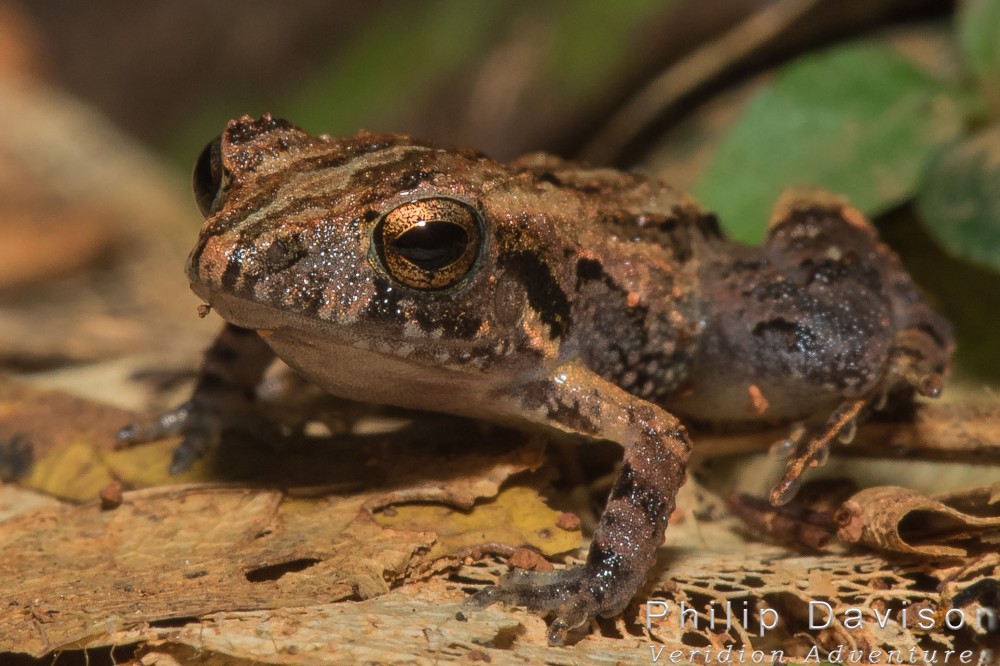
A tiny Stejneger’s Dirt Frog, (Craugastor stejnegerianus)
The dirt frogs are totally terrestrial frogs, they live their whole life on the forest floor and never need to go to water as many amphibians do. They still have moist skins through which they largely breath and therefore by necessity can’t leave the confines of the damp environment under the trees. There are several species that live in this area and Stejneger’s Dirt Frog is one of the commonest.
They belong to the family: Craugastoridae or the Fleshbelly Frogs. Typical of this family is the reproductive habit of direct development which negates the necessity of them having to return to water to reproduce. The frogs pair up, (I can’t say I have ever heard these frogs calling), and the female lays her eggs amongst the leaf litter on the forest floor. There are only about 20 – 30 eggs but they are fairly large in comparison to the adults. The egg is packed with yolk and the tadpole develops within the egg, there is no free-swimming tadpole stage. After about 8 weeks a tiny copy of the adult emerges.
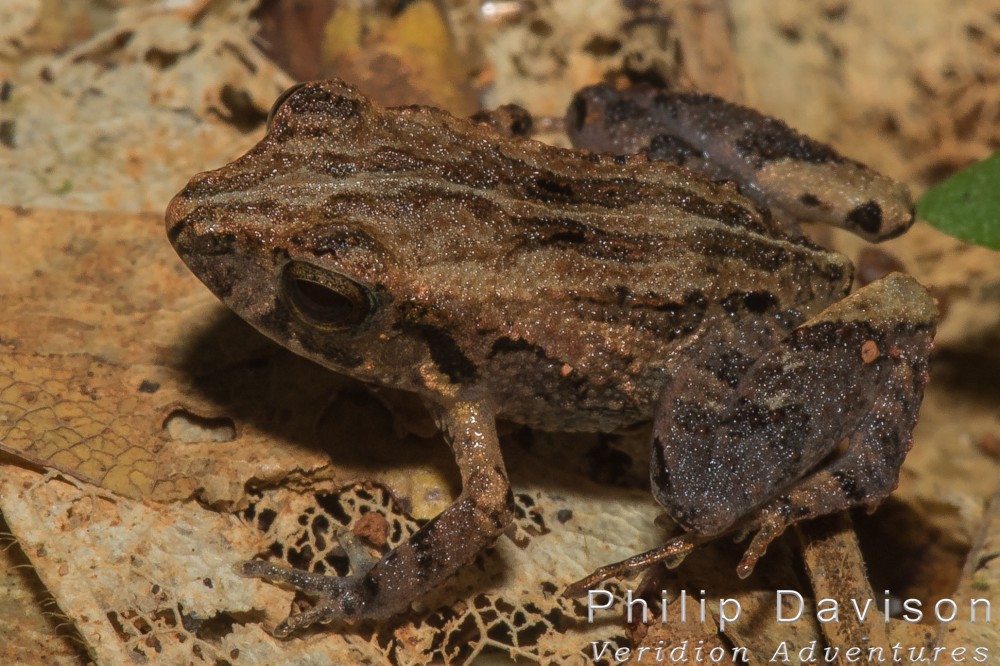
Dorsal view of Stejneger’s Dirt Frog, (Craugastor stejnegerianus)
As you are walking through the forest, if you keep your gaze lowered scanning the ground then you will surely see a small piece of the earth move. Given closer inspection then you will probably find you are looking at a dirt frog. But take a photograph as they are not always easy to identify.
Fying Dragons.
A few weeks ago I managed to photograph a dragonfly with black bases to the wings, a Black-winged Dragonlet, (Erythrodiplax funerea). This week I managed to capture another dragonfly but with the inverse situation of having black tips to the wings, the Large Woodskimmer, (Uracis fastigiata). This one was found in a different area to the previously mentioned species but they had been there for several weeks. This species was found in secondary forest, in a light gap and always close to the ground. Once again my attempts to take a picture were always doomed to failure because every time I lifted the camera to my eye, they would fly off. But as we know with photography patience is a virtue and finally after several weeks I got lucky. This one stayed still long enough for me to get several pictures.
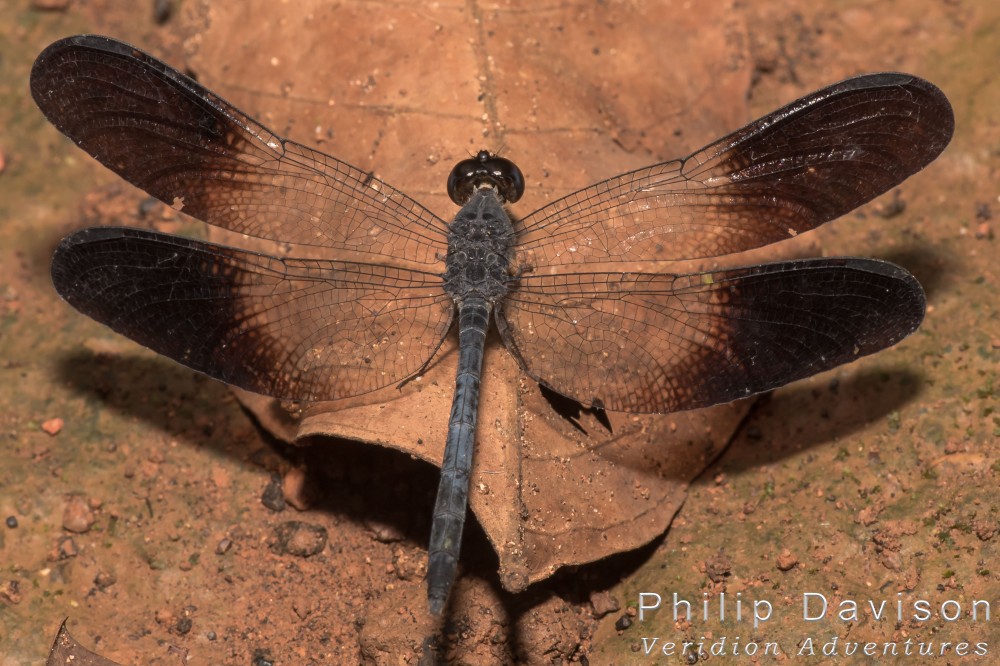
Large Woodskimmer, (Uracis fatigiata)
Unlike the dragonflies which can be found in open sunny locations around a body of water that have fast flight and hover, these forest species seem to be more sedentary and perch on low vegetation and only seem to move if disturbed. Having excellent eyesight adapted to detect movement it does not take much to disturb them. It could be that they are sit and wait predators just diligently watching for the right sized meal to pass by before taking off to capture it.
Philip Davison Is a Biologist, Writer and Photographer Based in Costa Rica

The weather on Cabo Matapalo continues to favor the visitor. Over the past week the days have been dry and sunny, there has been little rain at all. The rain that has fallen has been at night after everyone has returned to the comfort of their cabins. There was one afternoon when an electric storm developed over the tip the tip of the peninsula. Thunder echoed loudly throughout the forest, the rumbles seemingly shaking the ground beneath your feet, whilst simultaneously lightning sizzled and cracked overhead illuminating the surrounding area with blinding flashes of light. The rain poured vertically down from the heavens and within no time the paths had turned into running rivers. The whole event lasted little more than an hour and ended as abruptly as it began. The thunder rolled off into the distance, a herald of the deluge that was about to be visited upon the neighboring areas.
There would appear to be no letup in the enthusiasm of the breeding amphibians. Each night the number of calling males remains constant. The vegetation around the pond is covered in the eggs of many species. It is strange that this year should have seen a surge in the population of Small-headed Frogs, (Dendropsophus microcephala), which previously have been present in small numbers but this year have exploded to the point where they are the most vocal of nightly serenaders.
This has also been an exceptional year for the White-nosed Coatis, (Nasua narica). They are normally to be found around the gardens and throughout the forest and therefore are easily encountered. One of the first animals people see upon arrival are the coatis with their striped tails, slightly curved at the tip, stuck directly up in the air. The males are solitary and tend to bolder in their approach to people. The females, which band together in large groups with the young, until recently were more shy and retiring, they would run if you got too close. At least that is how it used to be. Now they are not so inclined to move out of the way. They will look at you with furtive glances, on their toes ready to run if you make a fast movement towards them, but if you move slowly they will continue about their business just maintaining a wary watch. It could well be that after so many years of being watched in this fashion that they have become familiarized with their human observers and no longer perceive them as an immediate threat.
A Touch Too Much
The sun is setting, its last red glowing rays now only picking out the top of the trees, creating the illusion that the canopy is on fire. You grab your flashlight knowing that the fire will rapidly fade into the burnt-out embers of dark red and ultimately dampened into darkness. With this darkness an awakening occurs, creatures of the night are beginning to emerge. Before all becomes blackness, the silhouettes of bats can be seen against the sky, leaving their daytime roosts to feed on all manner of food. Here the bats feast on a sumptuous banquet, each of the 80 species on the Osa Peninsula having its own preferred diet. There are insectivorous bats, nectar-feeding bats, fruit-eating bats, carnivorous bats, fish-eating bats and yes, even blood-feeding bats, the vampires.
In the background, the plaintive whistle of a Great Tinamou can be heard, its three ascending sad notes announce that the day has ended and the night has begun. As if on a collective cue, the insects start to call. The soft but rhythmic pulsating sound of katydids and crickets fills the still nighttime air. The shrill call of parrots and macaws fill the darkening sky as they pass overhead returning to their nightly roosts. Now, adding to the white noise of the insect symphony comes the call of the amphibians. They have been tucked away, hidden during the day from the harsh and drying effects of the sun’s rays, not good for creatures that breath through a delicate moist skin. But as the air cools it becomes damper, perfect for males to begin to emerge, set up a territorial platform and start to call. If he is lucky, a female will be attracted to the tone of his voice, oblivious to our ears, but sweet music to hers conveying the potential genetic quality that she would wish for her offspring. Finally the deep roars from the male Howler Monkeys as they settle down for the evening are telling you it is time to venture out.
You step out into the darkness, flashlight up by your eye scanning the area immediately in front of you looking for eyeshine. You are familiar with the various colors and the distinctive way the eyes of different animals reflect back at you. There is something. Fiery orange eyes on the ground, it blinks so it is not a snake, it hops up and down and then it calls and flies off. That you could identify quite easily as one of the nighthawks, a Common Paureque, (Nyctidromus albicollis). Now over there in a tree, more bright orange eyes staring down at you. You walk over to see what might be observing you. Before you get close enough to make out its form it calls, a Spectacled owl. It opens its wings, leans into the night and silently slips away, gliding like a feathered phantom into the blackness. So not a bad start to the evening.
There are diamonds sparkling everywhere, on the ground, in the vegetation, all colors, red, orange silver, green and blue. Anything with a diamond sparkle eyeshine you know is a spider and there are hundreds, no thousands of spiders, in whichever direction you look. Most of them are little more than the size of a pinhead.
Your free hand is resting on the low branch of a tree sticking out horizontally from the trunk at about hip level. You are glaring into the tangled vegetation in front of you looking for some of the amphibian choristers that you hear calling when you feel something lightly brush against your hand. You don’t retract you grasp quickly but rather gingerly lift your hand away and turn the flashlight in the direction of where it was resting. There you see the creature that had inadvertently made contact with you before withdrawing. Its body is large and hairy, it has eight stout and hirsute legs. Your pulse races and a bead of sweat rolls down by your eye from your brow. It could be due to the heat of the night but it is probably because you are looking at a tarantula.
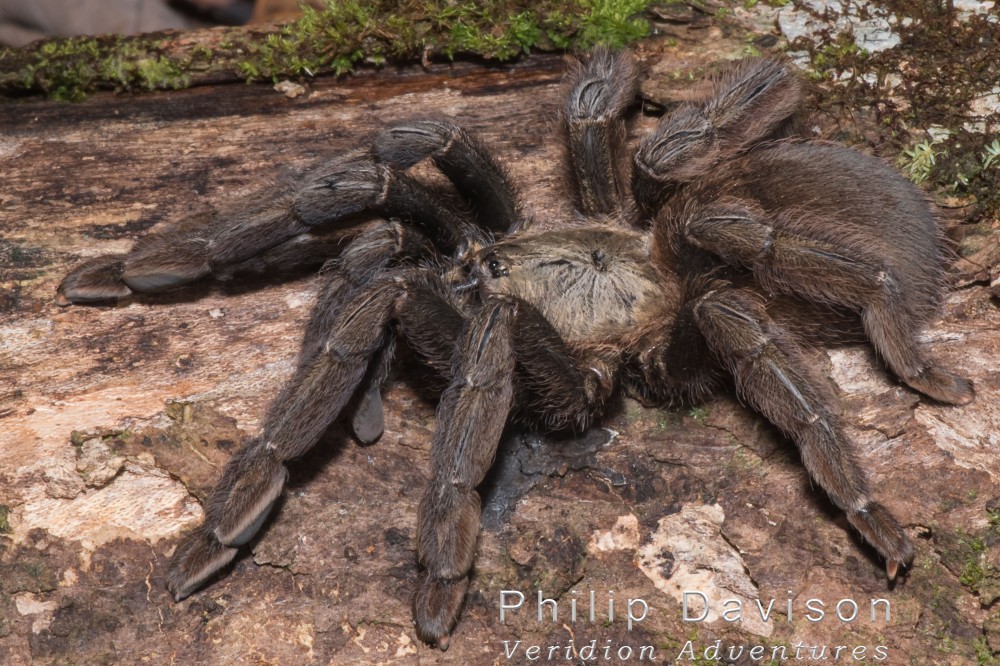
Unidentified Tarantula species in the Costa Rican rainforest
Tarantulas And The Dance Of Death
Now mistakenly putting your hand on a tarantula in the dark would increase the heart rate of most people but like so many other maligned creatures, the poor tarantula has a reputation it does not deserve and nor can it live up to. Despite their size and grotesquely fearsome appearance, tarantulas are shy and mostly harmless creatures. They are however venomous and a large, hairy, many-legged venomous arthropod is generally going to suffer bad press amongst their misinformed human observers.

A rather shy Tarantula does not want its picture taken
Venom is a complex cocktail and quite often it can be very different and peculiar to different types of spiders depending upon their preferred dietary prey species. Once a spider catches its prey, the victim must be rendered immobile very rapidly, especially if it is not caught in a web and then swaddled in restraining silk. Most venoms therefore contain fast-acting metabolic toxins that kill or paralyze the prey rapidly. In this respect, tarantula venom is very weak and does not have much effect on humans but it will kill dogs. Spiders do not have mouthparts capable of mastication so essentially they have to drink soup, that soup being the digested internal organs of their prey. The venom contains proteolytic enzymes that break down and liquidize the tissues so that the spider can suck up the rich protein meal and finish the process of digestion within its own alimentary canal.
So why does the tarantula have a reputation of being so dangerous. The story has its origins in a city located in mediaeval southern Italy called Taranto. Here lives a wolf spider, (Lycosa tarantula), one bite from which would drive the victim into a state of frenzied madness more commonly known as tarantism. The unfortunate sufferer was prone to dizziness, vomiting and a heightened sensitivity that compelled them to lose all inhibitions and dance in a wild state of abandon trying to release themselves from the effects of the venom.
Due to these effects, it has been suggested that the spider responsible was Latrodectus tresdecimguttatus, closely related to Black Widow of the U.S.A and the Red-back Spider of Australia. It may well have been that in a mediaeval Italy gripped by religious fervor that most cases of tarantism were little more than the result of a pious mass hysteria and not a spider induced dance of death. However the story travelled with European settlers to tropical America and from thereon the poor tarantula was saddled with the name and its resulting reputation from its smaller, deadlier European cousins.
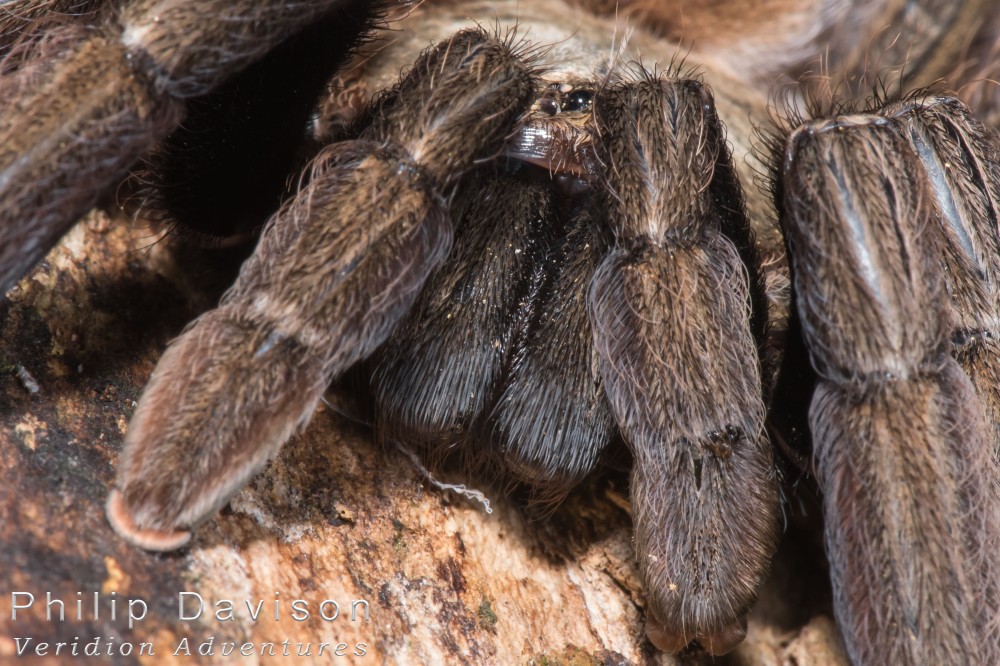
Tarantula sp – look closely and you can see the fang-tipped chelicerae
The tarantula in these photographs was found last week on the grounds here. It was not very co-operative and shied away from having its picture taken. When I tried to get a close-up on the fangs, it pulled all of its legs up against the body. I did manage to get low down and in front to get an image that if you look closely reveals the two fangs, which in the case of tarantulas are parallel to each other and face forwards.
Small But Deadly
Talking of smaller spiders, there is one species I see commonly around the buildings of the area that could be quite easy to miss. It prefers dark corners where two walls meet at right-angles. It is dark ruddy-brown and spends the day with its legs tucked up under the body. The web is little more than a few silken strands strung between the two wall faces. What draws your attention is not the spider itself but the size of prey it captures and consumes. I quite regularly see everything from large kaydids, beetles and moths dangling helplessly from the sticky diaphanous cords as a tiny spider cautiously approaches to deliver the coup de grace.
Although I do not profess to being an expert with regards to spiders, (nor with anything in fact), I think these tiny assassins belong to the family: Theridiidae, which includes the notorious Black Widow, (Lacrodectus mactans). The venom of the spiders in this family is highly neurotoxic which would explain why prey so much larger than the spider rapidly succumb to its bite. I don’t know anyone who has been bitten by one of these individuals I commonly find lurking in places like bathrooms and have no great desire to try and find out for myself.
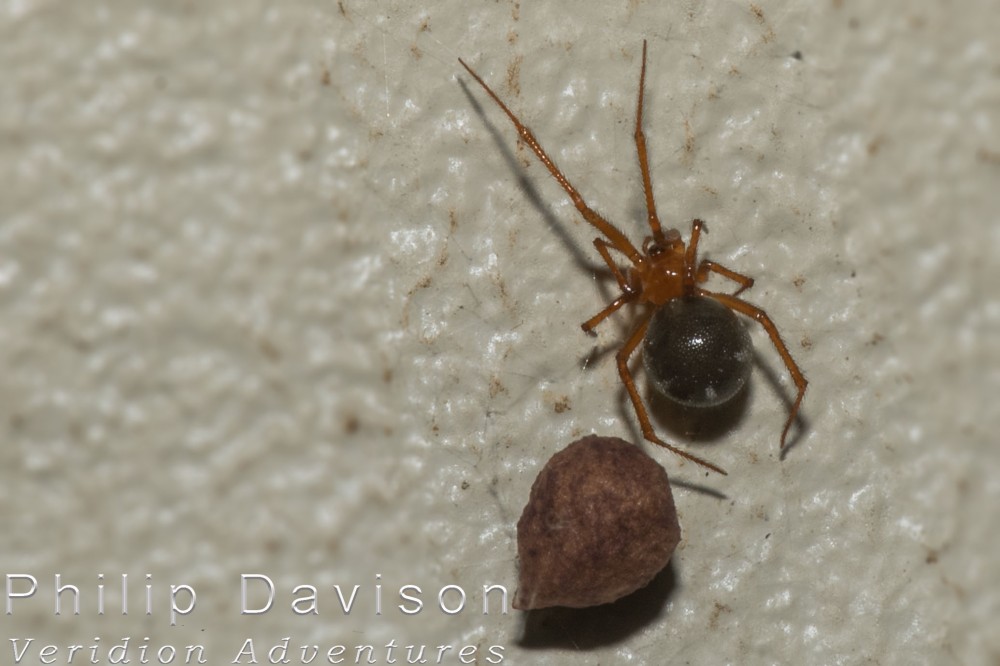
Tangle-web Spider female guarding egg cocoon
The individual in the photograph sat guarding a grey sac for many days. This is the egg cocoon. She will mate with a male then lay her eggs which she will wrap in silk in order to protect them against the environment and parasites. When these ones hatched I would see them swarming all over a prey item along with the mother. I never saw her wrap a victim in silk, they just remained suspended in death pose from the strands upon which they had initially and unfortunately become caught.
Choking On A Poisoned Thorn
One more spider that I found last week in the gardens is so distinctive that it can be identified immediately, at least to genus level. This is one of the Spiny-bodied Spiders, (Micrathena sp). They are small but tend to be dressed in bright and contrasting colors so you should not have too much trouble finding them if you are diligent in your searching. They are orb-weavers but the web, just as its maker, is relatively small. Spiny-bodied Spiders are more commonly found in the open areas rather that within the depths of the forest. Their webs can be found strung between the twigs and branches of bushes and small trees.
Once you have located one of the Spiny-bodied Spiders you will quickly appreciate why is bears that name. The rear of the abdomen is drawn out into two long vicious-looking thorns at the base of which are two shorter spines. The dorsal surface of the abdomen has a pair of upward pointing spines while the ventral surface has one downward pointing spike. This whole appearance is not an appetizing prospect for a potential predator. The coloration of bright vivid primary colors against darker background colors actually make the spider stand out in contrast to its surroundings. If it is visibly obvious then it is patently not trying to hide. It is using warning, (aposomatic), coloration to advertise its presence to a predator.
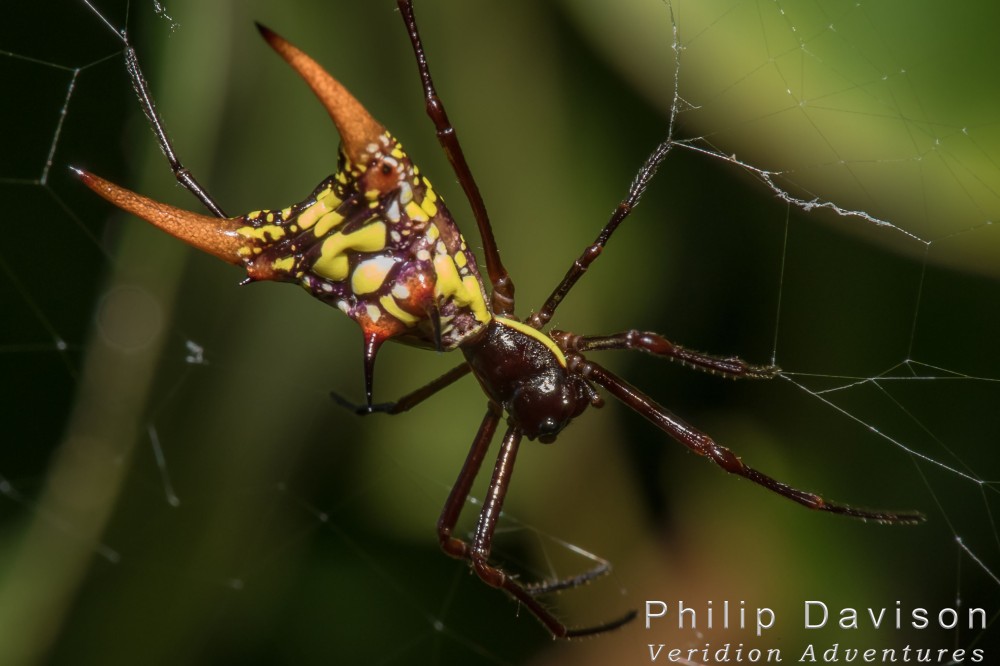
The spines covering its body are a clue to the naming of the Spiny-bodied Spider, (Micrathena sp)
Should a naïve predator such as a bird or lizard ignore that warning signal and try to feed on the spider, those thorns and spines will lodge it in the unfortunate creature’s mouth from which it is very difficult to displace. The spider meanwhile produces a noxious secretion that tastes foul and the hapless predator, rather than relishing a tasty meal, is now stuck with spiny vile dietary experience. One the spider is dislodged, the predator will never, ever go near anything sporting aposomatic colors again.
Shadowy Parasites – Not Green And Not Seen
While walking the trails I found a weird little plant that could easily be mistaken for a fungal fruiting body. It grows from the ground with a short fleshy stalk holding up the flowering head. The overall color is the same as the ground, a ruddy-brown, there is no green to be seen. In appearance it looks like no other flowering plant. It contains no chlorophyll because it is an obligative parasite. It taps into the roots of trees from where it extracts all its nutritional requirements. This is Helosis cayennensis of the family: Balanophoraceae. They can be found in northern and southern hemisphere tropics.

Strange acorn-shaped inflorescence of Helosis cayennensis
The main body of the plant is an amorphous underground tuber attached to the root it is parasitizing. The flower head produces both male and female flowers both of which are small in size. Quite often they can be found in large clusters, especially this time of year, the wet season, growing out from the base of the tree they are sucking the life from.

No green to be seen – the parasitic Helosis cayennensis
Philip Davison Is a Biologist, Writer and Photographer Based in Costa Rica

Transition, that is what is occurring now. The days remain largely sunny but the rain has started to increase in volume, intensity and duration at night. The creek running through the area is always a good yardstick by which to measure how dry the ground is. This year the creek never dried up and as of this week the flow is fast and the level high. The small cascades along its course are looking very picturesque with the water tumbling from higher to lower levels into the plunge pools, babbling softly as it does so and sounding like playful water nymphs inviting you to join them and cool off in the heat of the day. The water here is clean and crystal clear, its depth holds no latent or potential disease and the only animal life is the occasional sighting of a tropical crayfish hidden beneath a submerged rock, its bright blue body being visible to only those with the keenest eyes.
The Puma, (Puma concolor), has been seen again and its tracks could be found on several trails around the grounds. The past week has also been a good one for seeing the Squirrel Monkeys which are normally a little more retiring living as they do in the thickets of secondary forest. At the moment they have been making daily excursions in large numbers through the gardened areas.
The repetitive call of the Bright-rumped Atilla, (Attila spadiceus), had fallen silent for some months but once again they have started up and bursts of “Read it, read it, read it, read it” can be heard again echoing around the trails in the early morning. The frog breeding season normally starts with the first rains in May and then by the end of July it is over. Not this year. Every evening, just after sunset, the various species of amphibian emerge en masse, the males begin to call for a mate and by next morning the vegetation on and around the pond is covered in frog’s eggs.
Armored Four Sight
It is dark in the forest. You can’t see much. Your flashlight illuminates the path in front of you but the beam does not penetrate very far into the blackness and it also casts deep shadows. There is something moving in those shadows. You stop and listen. It is not something small. You shine the flashlight in the direction of the movement, your eyes peering into the gloom. You still can’t make out any shape but the sound of the creature advances ever closer. It crashes forward a few feet then stops for a moment and then moves again. You can start to see the dead leaves and fallen twigs moving. Your heart is in your mouth, it is almost upon you. Then silence. It is suddenly aware of your presence and it has stopped, motionless, whatever it is probably eyeing you as a meal. Then crash, it takes flight and rushes across the path in front of your feet. No wonder it sounded like a small tank rumbling across the forest floor, it is a mini armored insect feeder, a Nine-banded Armadillo, (Dasypus novemcinctus).
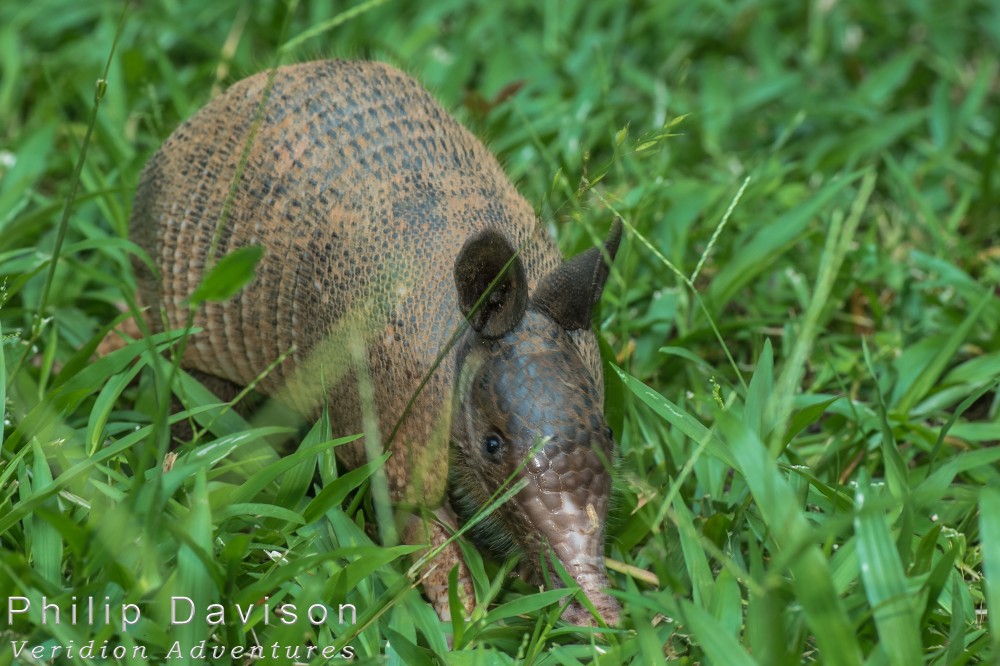
Juvenile Nine-banded Armadillo, (Dasypus novemcinctus), grubbing for food
Armadillos rank alongside sloths as one of the mammals that people would like to see when they visit the forests of the Osa Peninsula. They are not as readily found as the monkeys, agoutis or coatis but they are here and they do show up fairly frequently. They are encountered more commonly at night but it is not unusual to see them trundling around on the ground during the day too.
Armadillos belong in the ancient mammalian order: Xenathra along with anteaters and sloths. Nine-banded Armadillos have a large geographic distribution. They are found from the Southern United States through Central America down into Argentina. Between 4 – 2 million years ago when the southern part of Costa Rica and Panama rose out of the sea to form the land bridge between the North American and South American continents it provided a means by which terrestrial animals could move between the formerly separated land masses. Many northern species moved south and survived. Only three species moved north and survived; opossums, porcupines and the Nine-banded Armadillo. Nine-banded Armadillos have a large geographic distribution. They are found from the Southern United States through Central America down into Argentina.
There is no mistaking an armadillo for any other type of creature. The body is covered in a shell composed of bony plates within a keratinous horny skin. The eyes and ears of an armadillo do not function too well. The long snout provides an excellent sense of smell which is essential in the location of food. The majority of the armadillo’s diet is insects. It has powerful claws which it uses to grub up a variety of ant and termite species from the ground. With the nose stuck in the dirt, an armadillo can hold its breath for upto 6 minutes while it feeds on a particularly good banquet. Those claws also dig out burrows in which the armadillo lives.
Reproductively armadillos are very interesting. The female armadillo can delay implantation of the fertilized egg into the uterine wall if the prevailing weather or feeding conditions are less than optimum for its survival. The egg always divides into four which means that the female armadillo will give birth to four identical quads.
Last week as I headed out for a walk I saw four of these juvenile siblings snuffling their way through the lawn, heads stuck in the ground, turning over the earth in search of a meal. They had absolutely no idea I was there. I took some photos and then lay on the ground to take some photos as they came trundling towards me. It only dawned on them that I was there when one hit the camera. The first defense response of an armadillo is to jump, albeit not too high, and then run off. The first one to make contact with me turned and ran but the others still had no idea of my presence. The adults are no better. I have stood still in the past and had large armadillo running back and forth over my feet. Should anything alarm them and they take flight, their short-term memory is little more than a few seconds before they return about their business as if nothing had happened. I enjoyed watching these youngsters for a while before heading off and leaving them to feed and hopefully avoid coming across something that might not be as benevolent as I was.
All That Glisters
Down amongst the leaf litter a glitter of polished bronze slips under the leaves. As it passes from beneath one leaf to the next you can see a metallic object glinting momentarily before disappearing again. It moved too quickly to truly see what it was but you persist. There it is again. You bend down to move the leaf where it went, but nothing. Then you see it just a hands breadth away. A small head looking at you with intent dark eyes. It is a lizard or more particularly a skink. It is tiny with an elongated body and shiny smooth scales. The scales catch the light and reflect a bright dark copper. You find yourself looking at a Brown Forest Skink, (Sphenomorphus cherriei).
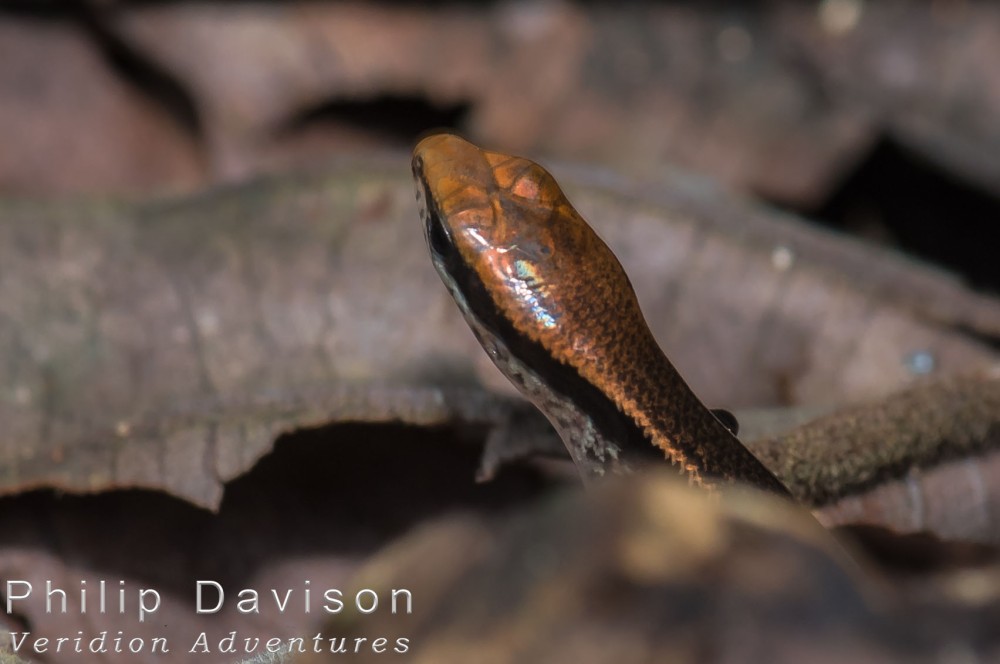
Brown Forest Skink, (Sphenomorphus cherriei), looking out from under a leaf
Several weeks ago I took photos of yet another small leaf litter dwelling lizard, the Northern Spectacled Lizard, (Leposoma southi), and stated that I really wanted to find and photograph the Brown Forest Skink too. It is no easy task as they move quickly and once beneath the leaf litter ‘swim’ in a serpentine fashion through the decomposing vegetative material. This one poked its head out long enough for me to get a quick shot or two. I will have to keep looking to get the full body shot.
The hard and shiny scales of a skink may serve several purposes. They help it glide between the material of the substrate making up the leaf litter in which it lives. But there are lots of birds hopping around close to the forest floor whose keenly acute vision would spot a meal such as skink very quickly. If caught in the bill of an avian predator the scales allow the skink to slip out and hopefully, as far as the skink is concerned, make its escape.
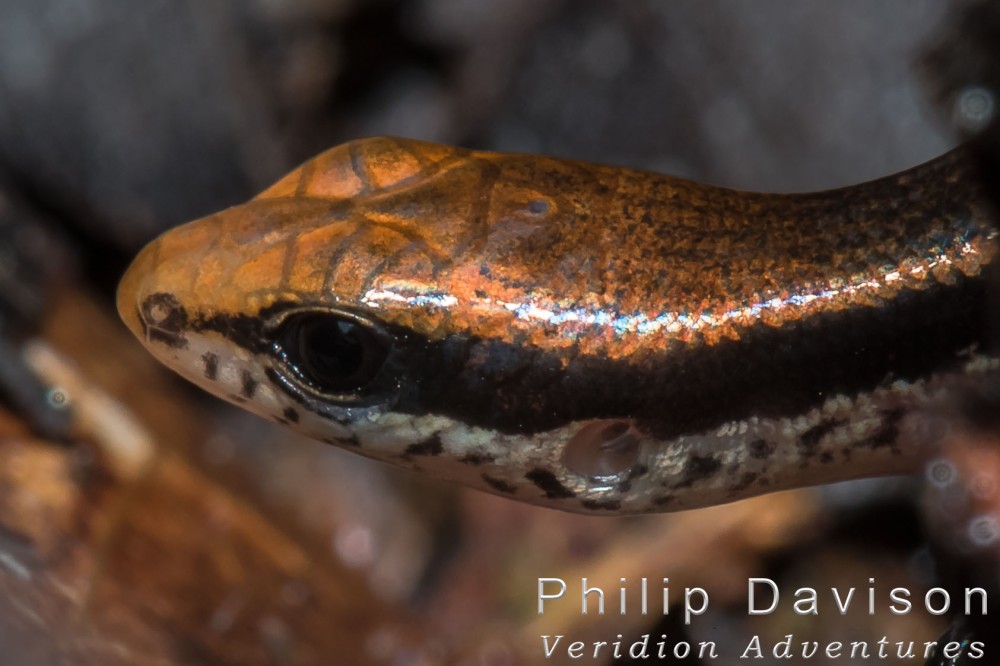
Brown Forest Skink, (Sphenomorphus cherriei), close up of head
Dressed In Black For The Telling Of Dark Tales
Walking on the forest trails you see a something take flight and then settle again on another plant. The overall aspect is of an insect cloaked in funereal colors. The body is black and the wings have black banding. Nonetheless it draws your attention.
The creature is a Black-winged Dragonlet, (Erythrodiplax funeralis), a common dragonfly found inhabiting forest rides or at the edge of open areas. Dragonflies are restless predators. They are on the constant look out for a meal. They are easily disturbed too. Those huge eyes and mobile head can spot a potential predator or prey item very quickly. If it is the former they fly to another perch. The Black-winged Dragonlet has a much more fluttery flight than some other dragonflies which seem to dart back and forth.
They catch their prey on the wing which means they feed on flying insects. Should a meal fly by the dragonfly swoops in and catches in its legs which form an open basket beneath the thorax. The legs are covered in spines which make it difficult for the victim to escape. Once ensnared, the prey will be dispatched, the hard body parts and the wings dumped to the ground and the rest of the body consumed.
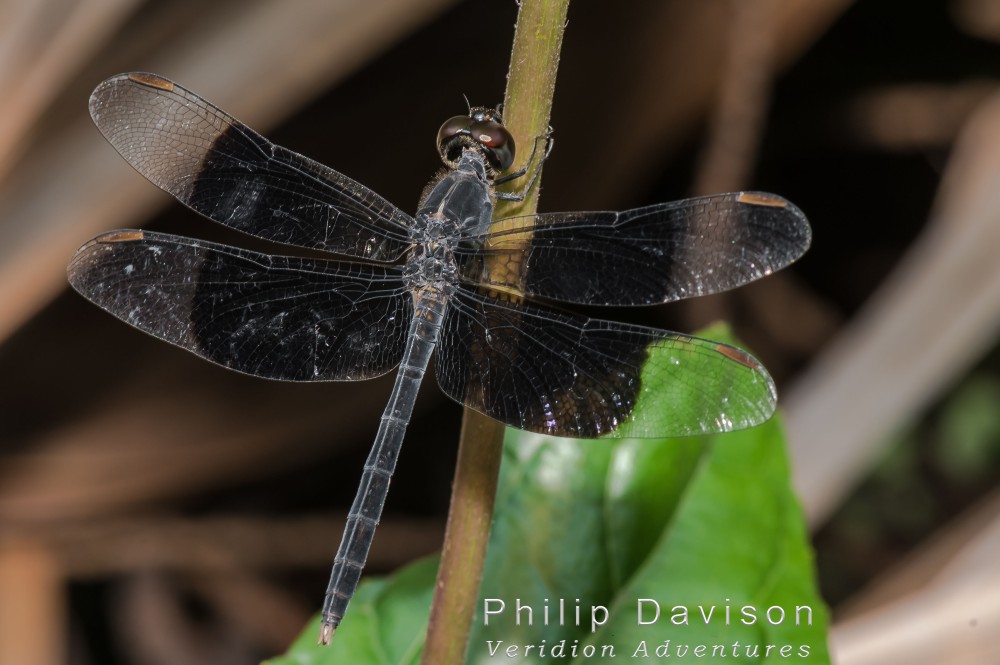
Black-winged Dragonlet, (Erythrodiplax funeralis)
Dragonflies can present a challenge to photograph. They are acutely visually aware, they move quickly and they don’t like being approached. This one I had to follow, very slowly and patiently, before I managed to get a photograph. It did take a good few attempts as it kept moving from perch to perch and I was on the point of giving up when it seemed to settle, at least long enough for me to hit the shutter several times. Anyone out there who has tried photographing flying insects knows that patience is an essential virtue if you are going to obtain any images.
Philip Davison Is a Biologist, Writer and Photographer Based in Costa Rica

Following last week’s heavy rainfall, this week the weather has taken a turn in the opposite direction. We have seen a lot of sun during the day and later as the sun sets clear evenings reveal a sky filled with stars. Each walk through the forest would result in a return to base with your boots heavy with clinging mud. Now the ground is still soft but remains in place and not so much covering your feet.
Normally at this time of year the Osa Peninsula, Costa Rica experiences a brief, but welcome, climatic anomaly known as the “Veranillo’, or little summer. For a two-week period in the middle of the wet season the atmospheric and oceanic currents conspire to produce a situation where the conditions dry up. It is a false dawn giving hope to the ignorant that the wet season is over. In fact it is a prelude for those experienced in reading the signs of what is imminently about to happen, the full wet season is due to be unleashed. But at least we can enjoy a short period of heat and light before enduring three months of daily tropical deluges.
Lazy Cats and Strange Sightings
Last week was exciting for a variety of reasons. One day, late afternoon, a Puma, (Puma concolor), was spotted lying on the ground under a bush just off to the side of the road. Everyone in the near vicinity was alerted and proceeded to congregate in an area where they could safely observe, video and photograph the wild cat. The Puma was fairly unconcerned about the mild disturbance to its siesta and continued its nap.
After a short while, it slowly rose to its feet and walked nonchalantly in front of the audience, not even casting a glance at those desperately attempting to takes its portrait. Everyone’s hearts were now beating heavily in their chests, this was a big cat and it was no more than 30 feet, (10 meters), away. For many people this was a once in a lifetime opportunity and they captured so many excellent images. The cat finally made its way toward some denser vegetation and disappeared into the darkness.
Whereas close proximity to a large wild feline causes a lot of excitement, for most people the sighting of a hitherto unseen butterfly would not. Well, not except for me and one or two others that is. Last week I saw a new butterfly species that I had previously not recorded for the Osa Peninsula. The butterfly was so distinctive ensuring there was no possibility of an incorrect identification. Sadly I did not have my camera in hand so was unable to obtain photographs.
On the day in question, just after lunch I saw a butterfly flying around the garden, not too fast and occasionally landing on the ground. It was not a sight I could miss as the upper surface of the wings had two bright postbox red stripes running over a black background. This contrasted vividly with the green of the grass. I followed the butterfly trying to commit to memory the markings and coloration so that I could remember them later for an identification. I had an inclination of what it might be but just needed to verify it.
A quick look at the excellent reference book, “The Butterflies of Costa Rica” by Philip J. DeVries solved the mystery. The butterfly was a Red Banner, (Temenis pulchra). It ranges from the Amazon Basin and reaches its northern limit of distribution in Costa Rica. This individual was a male, which despite normally only being found at canopy level, will sometimes descend to the ground to visit mammal dung or urine. Whatever it was looking for, I was happy to add one more new species for the ever-increasing inventory for the area.
Blue Bug – The Showdown
This has been a good year for bugs, true bugs. I have managed to photograph a good many species even though I have not been able to put names to them all. There is one that has eluded me though. It is a reasonably common Shield Bug, but for whatever reason I could never find one that would stay still long enough to have a photograph taken or if I did manage to get a shot, the resulting image was not of a usable quality. Last week, all of that changed. I found one that stayed still, at least momentarily. I managed to get several shots, even though it took to the air several times, but it always came back again.

Red-bordered Stink Bug, (Edessa rufomarginata)
This is not a bug that you could easily miss. The upper side of the head, thorax and abdomen are turquoise blue, with bright red edging. The antennae are fire orange. The underside is pale yellow with black stripes and the legs too are orange. There is no mistaking that you are looking at a Red-bordered Stink Bug, (Edessa rufomarginata).
Stink bugs belong in the true bug order: Hemiptera and the family: Pentatomidae. It is a widespread species ranging from Mexico in the north to Argentina in the south. Unfortunately they are a serious pest species on commercially grown species of the plant family: Solanaceae such as potatoes and tobacco, (although some might see destruction of tobacco plants as a good thing).
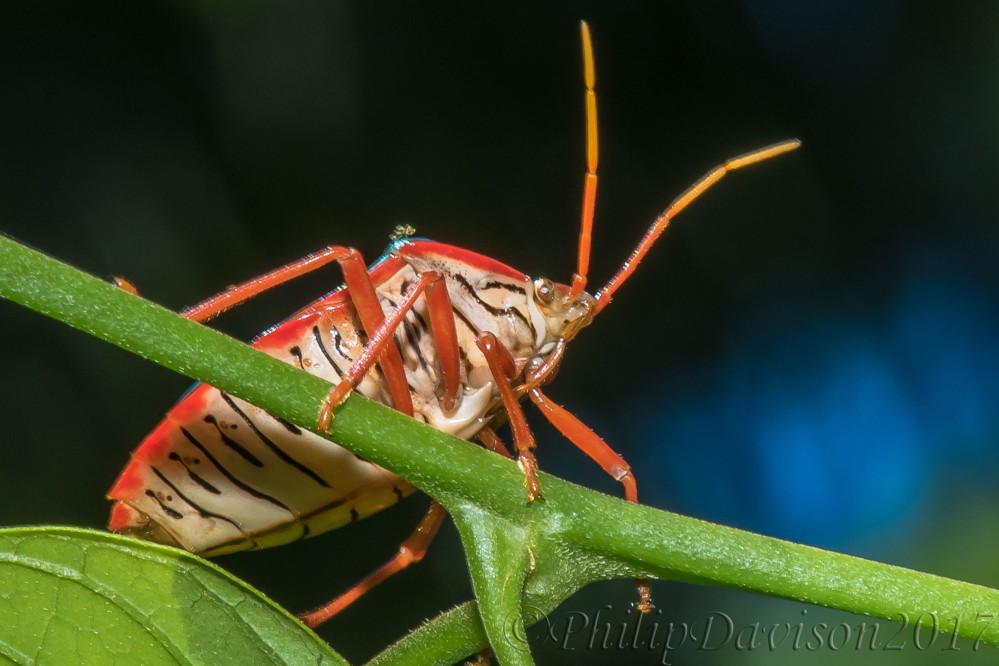
Ventral view of Red-bordered Stink Bug, (Edessa rufomarginata)
Not having a sense of smell, I miss many odors and scents that people find either delightful or repugnant. Stink bugs fall into the latter category. The stench they produce from glands on the abdomen is released in response to being in some way being put under threat. Apparently it smells very strongly of cilantro. But, however the less than pleasant odor smells, I was happy to have finally got my picture.
Milk From a Tree
There is a tree fruiting at the moment whose fruits can be seen lying on the ground at various points around the trails. There are only one or two individuals of this species of tree in this area but the fruits are an obvious indicator of their location. The tree is Palo de Pico, (Naucleopis ulei). The fruit is a small woody sphere of green and yellow coloration covered with softer fleshy finger-like protuberances of the same color.
The tree belongs to the family: Moraceae which is a cosmopolitan family composed of over 1100 species found mainly in the tropics but also in subtropical or even temperate areas around the world. There are 50 different species of Moraceae found on the Osa Peninsula.

The distinctive fruit of Naucleopsis ulei
One of the distinguishing features of many trees in this family is the milky white latex that exudes when they are cut into which gives rise to colloquial names such as Milky Tree, Cow Tree and Rubber Trees. All of these species can be found in the forests of this region.

White latex leaking out of fallen Milky Tree, (Brosimum utile)
One genus in this family that is very important in the forests are the fig trees, Ficus. There are 750 species of Ficus worldwide of which 23 species are found on the Osa Peninsula. Figs are one of the most important species of tree in the forest as they produce a year round supply of copious amounts of fruit. This in turn is important in providing a continuous food supply for so many of the animals in these forests. Significantly, if climatic conditions result in a low crop then so many fruit-eating animals from monkeys to toucans will suffer and may be unable to raise young during that particular year. Strangler figs are also responsible for the taking over and killing some of the more mature trees in a forest community.
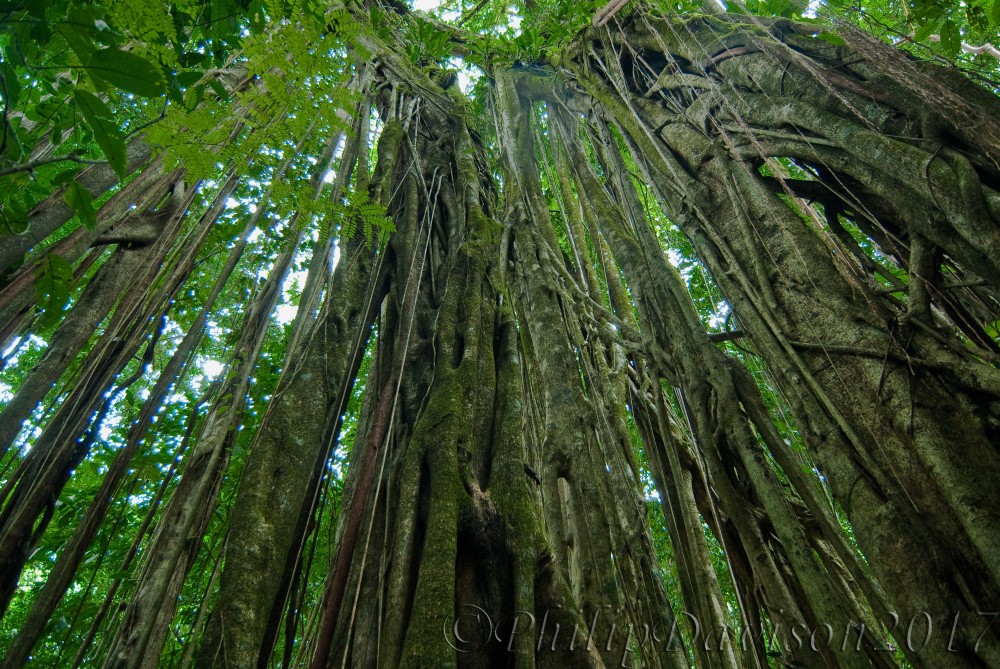
Amazing Strangler Fig, (Ficus zarazalensis), endemic to the Osa Peninsula
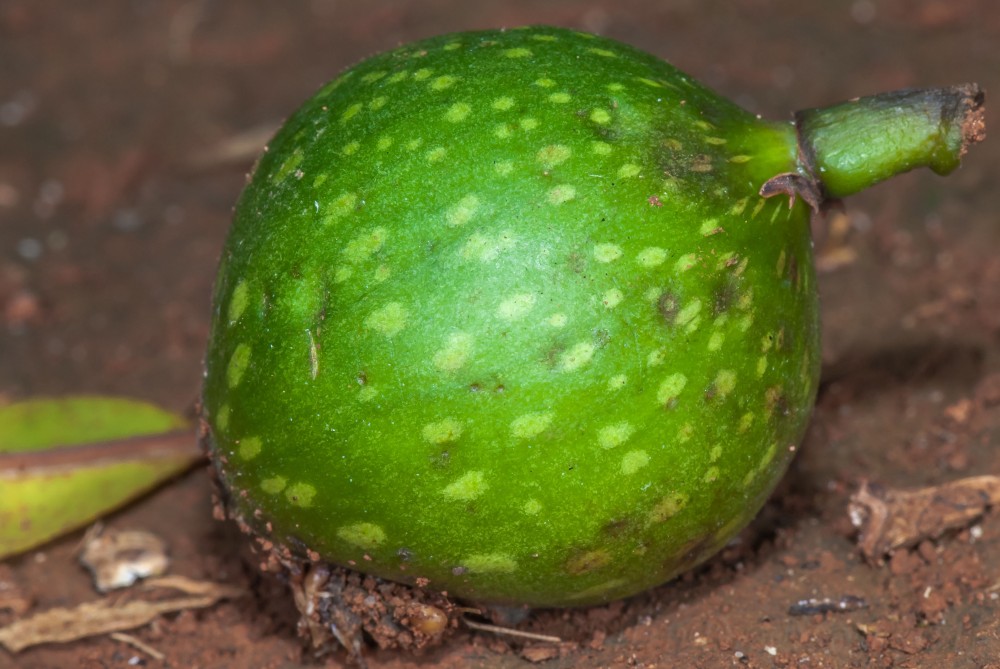
As the name suggests, not such a tasty fig, (Ficus insipida)
Philip Davison Is a Biologist, Writer and Photographer Based in Costa Rica

The rainfall of April, May and June from 2016 was more or less exactly the same in terms of monthly totals for the same periods in 2107 but this week has proved to be very wet. The rain has been incessant, both day and night with very little of the sun having been seen. A total of 15 inches rain fell and now the creek is running quite fast, so no water problems this year.
Spiders: Not Everyone’s Favorite
I have to admit that many people I take out would rather just walk straight past spiders and ignore their presence. Some people, despite their revulsion, are intrigued by their natural history, they are, after all, fascinating creatures. I find them interesting to observe, understand and photograph. They are mini carnivores with a wealth of different life histories. They are also ubiquitous, they can be found just about anywhere on the planet, (apart from maybe Antarctica), and in abundance. It is often stated that at no point in your life are you any more than six feet away from a spider and I can demonstrate the proof of that fact quite adequately every evening when I take people on the night walk.
There are approximately 40,000 species of spider distributed worldwide which makes them the eighth most numerously named group of animals on the planet. Although they are all, (apart from possibly one species), carnivores and use venom to subdue and kill their prey, they are not dangerous to humans expect for those well documented species, the numbers of which you could count on the fingers of your hands.
Spiders divide up into two broad groups. The first group are the Tarantulas, Trapdoor Spiders, Funnel-web Spiders and the Purse-web Spiders. The second group are all other spiders and they are subdivided depending of the mode of food capture. There are the Web Weavers; those spiders that produce the familiar silken webs but those webs also come in different forms. There are Orb-web weavers, Sheet-web Weavers, Tangle-web Weavers and Lace-web Weavers. Then there are Ambush Spiders such as Crab Spiders as well as Wolf Spides, Huntsman Spiders, Lynx Spiders, Fishing Spiders, Spitting Spiders, Jumping Spiders, Woodlouse Hunters and Wandering Spiders. All in all, if there is a way of catching prey, then spiders have it covered.
A Living Tetrahedron
I noticed this spider last week crossing the road in front of me. The bright yellow coloration was in marked contrast to the grey grit across which it was scurrying. As I bent down to take the photograph, the spider went into a defensive posture and tucked its legs up against the body. This made it easy for me but gives it a somewhat unnatural pose. I think this individual must have fallen from an overhanging tree branch, maybe escaping becoming a meal for a larger animal. Being bright yellow might work to disguise it amongst foliage but not against the dark grey of the road surface.
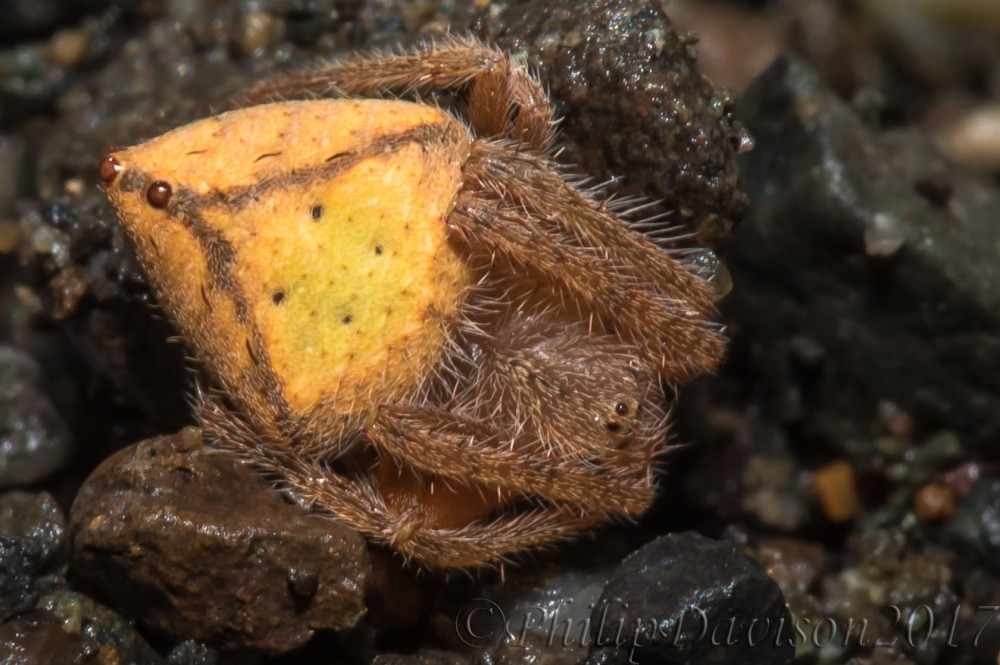
The strange tetrahedron shaped body of this unidentified spider
You can gauge how small the creature was by the size of the grit next to it which is only about 1mm across. When looked at close-up though you can see the spider is remarkably shaped. The body is drawn up into an almost polygonal shape, a tetrahedron, rounded along its edges. There are raised red nodules along the rear edge. You would think that these would make it an easy spider to identify, but no such luck. Extensive searching has not provided an I.D. I would hazard a guess that it is one of the many tropical orb-weavers. If anyone has a name I would be very grateful to receive it.
A Silver Orb in the Sun
Further down the road, in an open sunny area I saw a large web with the weaver sitting in the center, its eight legs forming a cross of four pairs. Because of its location I could not get around to the opposite side to get a dorsal view so had to settle for the ventral view.
This species I had seen before, on numerous occasions. This was a Silver-orb Spider, (Argiope argentata). The fluting of the body rim along with the black and yellow tiger striping of the legs are examples of disruptive form and coloration which serve to make the creature less spider-like. It is an effective form of camouflage used throughout the animal kingdom.

Ventral view of a Silver-orb Spider, (Argiope argentata)
The web itself is constructed from silken threads. Silk is an amazing material and deserves a book devoted solely to that subject. Silk is both elastic and strong. Orb-weavers can produce upto five different kinds of silk, each variety having a different use. Silk is produced as a liquid in the silk glands, it is then secreted from the spinnerets where it is drawn out by the hind legs into the long threads.
To construct the web, the spider first has to create a framework of threads radiating from the center. Then starting on the outside, it spins a spiral thread, round and around towards the center. The spiral silk is coated in a sticky hygroscopic glue which serves to catch any prey item unfortunate enough to fly or fall into it. The elasticity of the threads takes out the kinetic energy of an impacting large flying insect and stops the web from breaking. Silver-orb Spiders are fairly large and consequently so are their webs. They are reasonably common in the area so it does not take too much effort to find them.
Hidden Death Dealer in the Flowerheads
Sometime ago I noticed a butterfly behaving in a very strange way on one of the Lantana flowerheads. Further investigation revealed the butterfly was dead and the unusual movement was being caused by it being manipulated within the legs of a small but efficient killer, a Crab-spider.
Crab spiders are small squat spiders and receive their name due to their ability to walk sideways as well as forwards and backwards. They are ambush predators. Some have the capability of changing color over a period of weeks to match that of the flower where they are sitting and waiting for a prey item to land. In this case the victim was a White-banded Fatima (Anartia fatima).
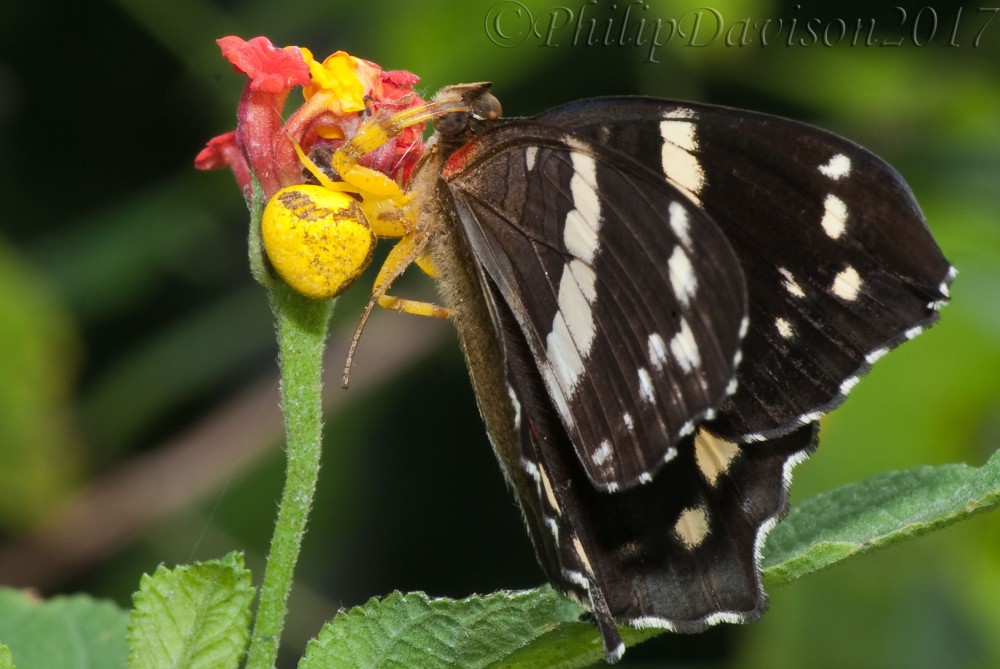
Unidentified Crab Spider captures, kills and eats White-banded Fatima
The butterfly would have been totally unaware of the lethal assassin’s presence. As soon as it landed to take a feed of nectar, the longer and stronger front two pairs of spider legs would have grabbed it. The butterfly’s wings would have been beating frantically but taking flight was no longer possible. At the same time, a powerful venom would have been injected through the spiders fangs into the butterfly’s body killing it almost immediately. The spider holds on until the venom has done its work. The wings stop beating and the now lifeless butterfly is motionless. Digestive enzymes injected with the venom liquidize the butterfly’s innards which the spider will then suck out as a soup. It will then let the dry and drained husk of the victim fall to the ground.
To find crab spiders you have to search diligently among the flower heads. Sitting patiently without moving and having the same color as their ambush position makes them difficult to spot. Sometimes the only clue to their presence is the telltale sign of strange behavioral anomalies of their victims.
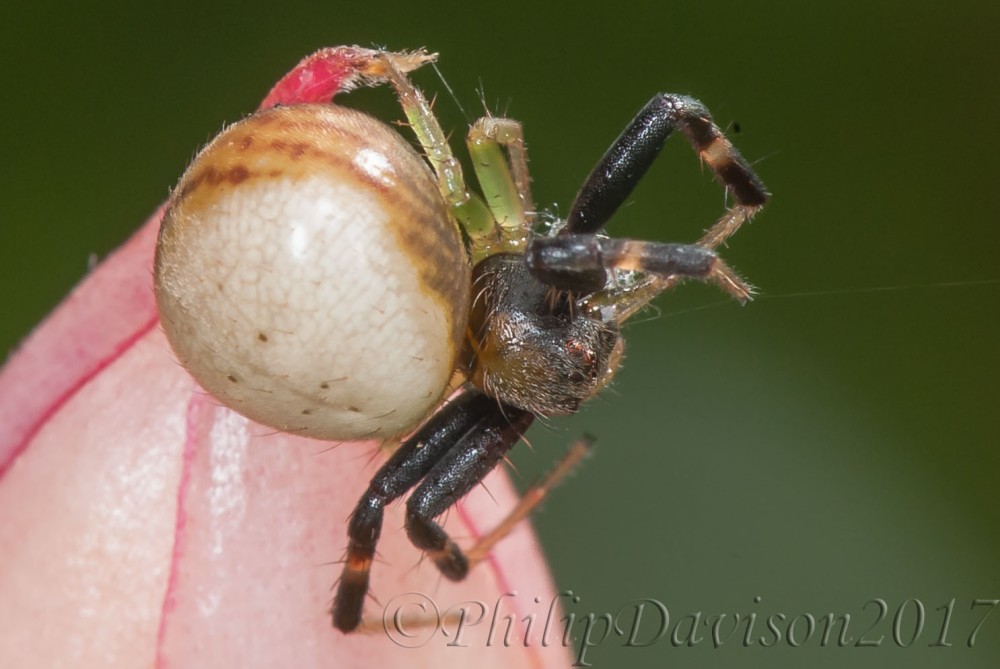
Death hidden by beauty. Crab Spider waits at tip of a flower for a meal to arrive
Philip Davison Is a Biologist, Writer and Photographer Based in Costa Rica

Over the past week the rains have continued, now sometimes during the day as well as at night. There have been some heavy downpours. One thing that can occur this time of year are the climatic phenomena known as temporals. Clouds will settle over an area for some days producing grey, overcast conditions with constant rainfall.
The water level in the creek has risen, not drastically, but enough to secure a steady flow. The mango orchard is the scene of a lot of activity with so many animals coming to feed from the bumper crop that is presently hanging from the trees. During the day spider monkeys and white-faced capuchin monkeys can be seen greedily feasting on the abundant and ripening fruits. Monkeys are very wasteful feeders, they pluck a fruit from the branch, take a bite and throw the remainder to the ground. Here the white-nosed coatis and agoutis take advantage of a free meal falling from above.
At night the mangoes are visited by kinkajous in the trees and pacas on the ground, the nocturnal cousin of the agouti. All manner of insect life feeds on the fermenting mangoes, everything from flies, bees, butterflies and at night, moths.
The Mighty Harlequin Beetle
One night while returning to my cabin I noticed a beetle, a very large beetle, on the vertical surface of a tree trunk. It was late and I did not want to set up the camera equipment so I placed the beetle in a collecting bottle in order to photograph it the next day. Beetles, due to the huge number of species are not always the easiest creatures to identify but there was no problem with this one. The color, the pattern, the long, curved antennae and the thin extended front legs allowed me to identify this one immediately. This was a Harlequin Beetle, (Acrocinus longimanus).
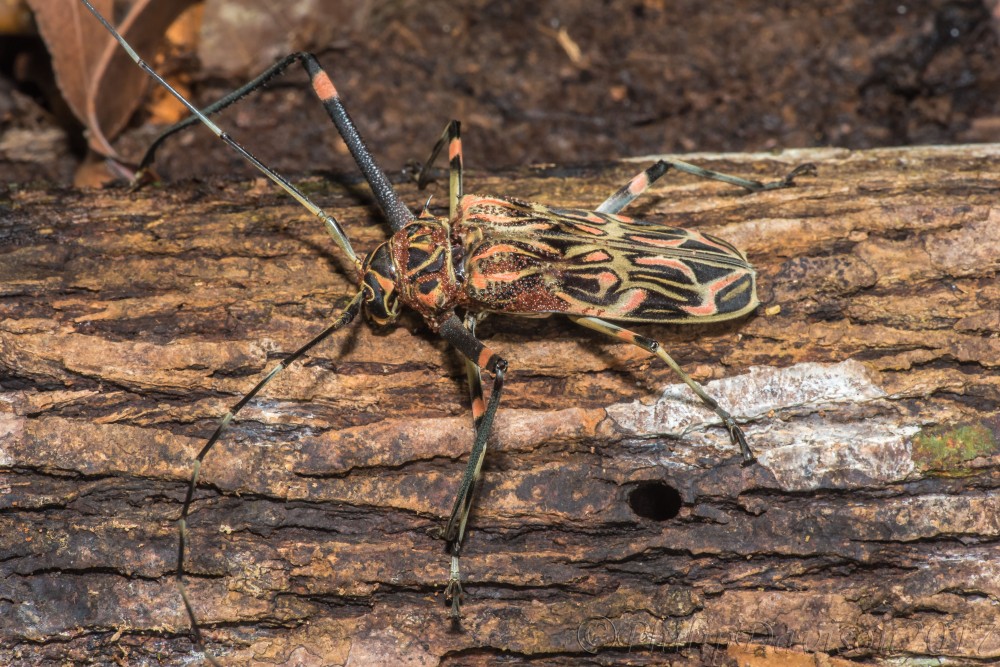
Harlequin Beetle, (Acrocinus longimanus)
The exquisite geometric black and red markings over a green background of this handsome beetle would appear to make it stand out rather obviously in the hand. But place it on a lichen covered tree trunk and it disappears from in front of your eyes.
Harlequin Beetles belong to the Longhorns of the family: Cerambycidae and are found throughout the Neotropics. If a tree noted for producing copious amounts of sap is either injured or damaged then you can expect many Harlequin Beetles turning up as if from nowhere.
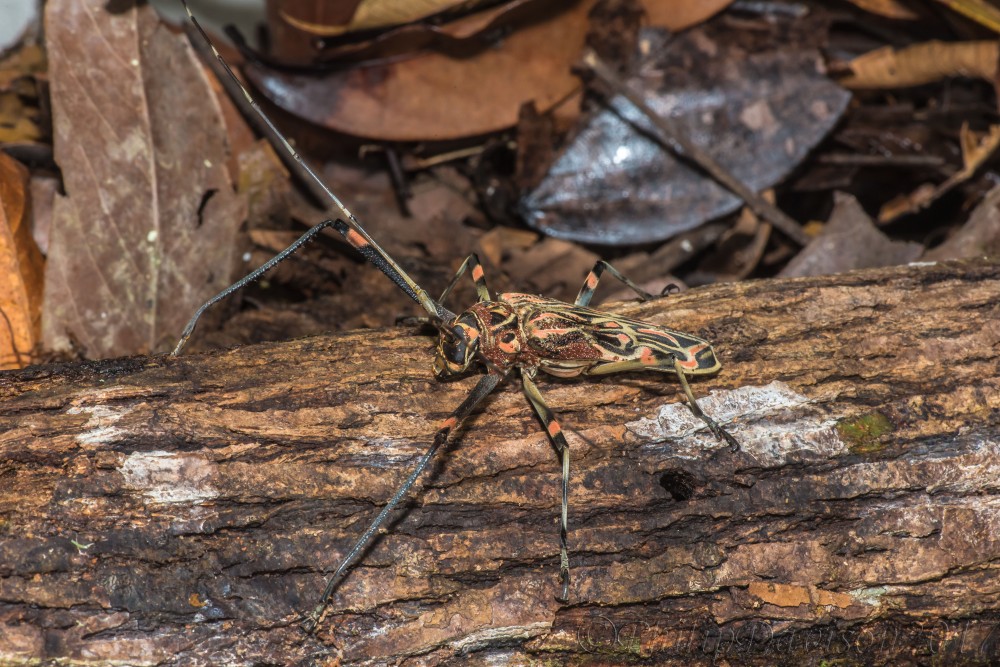
Strangely long front legs of a Harlequin Beetle
Both sexes have long extended front legs but the males much more significantly longer. It is thought that this is in some way related to mating. The beetles are active both day and night. The females prefer rotting wood already proliferated with bracket fungus in which to lay her eggs. The resulting larvae then complete their development within the now dead wood. For this reason they can be regarded as speeding the decay of non-living trees rather than a pest of live wood.
While I was taking the pictures, I noticed that the beetle was covered, particularly around the head and bases of the wings with a myriad of mites. Mites are arachnids and can be parasitic or predaceous upon other arthropods. They sometimes feed on the secretions of their hosts and other times use them as a means of transport, phoresy. Phoretic mites usually glue themselves to the host in order to hitch a ride without falling. Mites are a specialized and difficult group to study and the people that do so are few and far between. It is way beyond my ability to identify these mites. It could well be that they are one of the nymphal stages. There appear to be both orange and white colored mites. Once again I am at a loss as to whether these are of different species. The beetle did not appear to be too agitated by its infestation. If anyone has further information to help elucidate what was happening then I would be happy to hear from you.
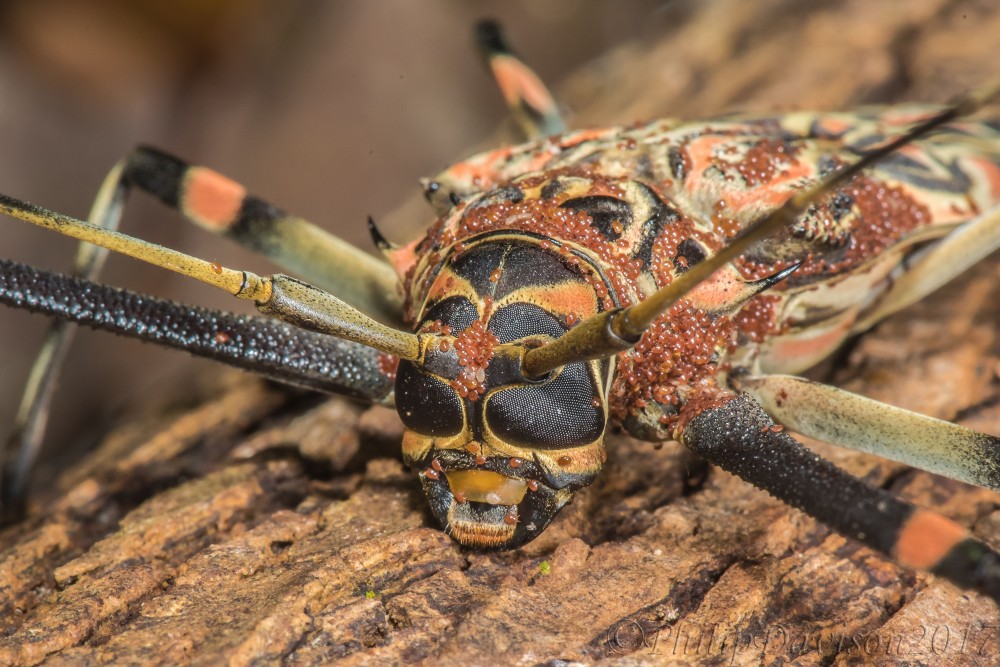
Close up of the Harlequin Beetle head showing the mite infestation
A Fleeting Glimpse of Blue
At the present there are lots of trees producing fruit, notably the figs. In some areas the ground is covered with figs in various states of decomposition. The scent of rotting fruit is irresistible to many insects that come to imbibe the liquifying and fermenting meal it provides. Some of the butterflies are drawn this intoxicating feast, the commoner ones being species of Blue Morphos.
As I was walking through a sunlit path in the forest I was met with a bright metallic blue morpho taking to the air from down by my feet. I had disturbed its meal of fig juice from the fruits that were lying everywhere. It was not going to be so easily dissuaded though and landed a short distance away on a tree trunk. Here it would wait momentarily for a few moments before circling around and taking up where it had left off feeding on the ground.
While it was stationary I took the opportunity to capture its image. I noticed one of the hindwings was damaged and the brilliant electric blue coloring of the upperwing for which the butterfly is named was visible. There are three species of blue morpho in this area, each one distinct from the other. This one was a male Morpho menelaus.
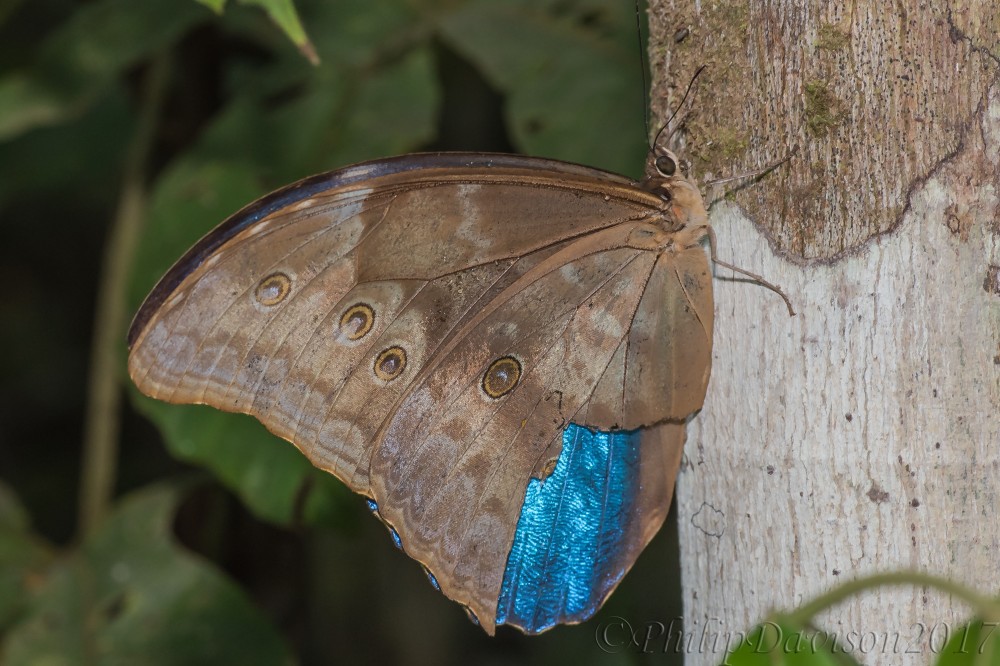
Torn hindwing of male Morpho menelaus reveals blue color of upperwing
Morphos are large butterflies and are unmistakable in flight due to their size and eye-capturing iridescent blue coloration. In flight they move with slow wing beats up and down, left to right. Each time they open their wings the bright blue appears but when the wings close then it disappears. For any predator trying to follow the flight path of a blue morpho, and with flying butterfly then that is generally going to be a bird, all that it is going to see is a stroboscopic flashing of metallic blue from different points in front of it making it impossible to follow. But there are always around systems and some birds, Jacamars, which are related to kingfishers, have learned how to intercept the morpho on its flight path. The perches of jacamars will have the discarded wings of morphos littering the ground below where they have eaten the bodies of the butterfly and dropped the wings.
Butterflies belong to the insect order: Lepidoptera, which translates into scaled wings. From the photograph you can see the lines of overlapping powdery scales that cover the wings. With the morphos the scales on the upperside of the wing are transparent but layered. In effect each scale acts as a prism. Light entering the scale is broken down and the blue light is refracted back out. So the blue coloration is not due to pigment but rather the refraction of light.
One of the other species of morpho found in this area, Morpho cypris, is one of the most highly iridescent insects on the planet. It will only be seen in the morning and only found flying at the level of the canopy, 100 feet or more above the ground. Should you be on a tree platform or a canopy bridge you will be astounded to see what appears to be a diffuse metallic blue sphere floating through the tree tops. It is an absolutely phenomenal sight.
Unseen Red
One of the more frequently encountered snakes in the area is the Tropical Bird-eating Snake, (Pseustes poecilonotus). They are one of a handful of larger snakes to be found here, which is good in as much as that limits your choice when it comes to identification. They can grow to about 6 feet in length. Most of the individuals I have found are a muted green color with pale red bands along the body. The belly is usually yellow and the top of the head black.
On one of my walks, in the open before the forest entrance, I heard a rasping sound which I knew immediately as the rubbing of dry scales against each other heralding the presence of a snake. I looked down and there close to the forest edge was a beautiful Tropical Bird-eating Snake. This one was so striking as it did not have the normal coloration but was rather an overall vivid scarlet with tinges of orange suffused around the lips.
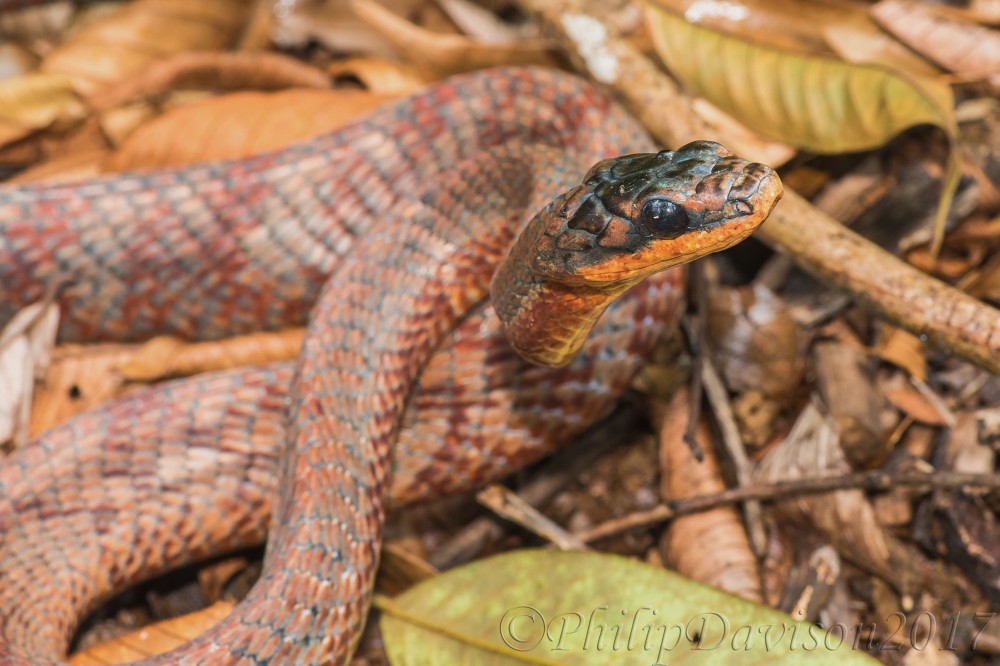
Unusually red-colored Tropical Bird-eating Snake, (Pseustes poecilonotus)
As the name suggests these snakes eat birds as well as chicks and eggs from nests. They are non-venomous but can be irascible. If you approach too closely they will laterally flatten the neck to give the appearance of being larger than they are. They open the mouth and hiss which gives them the alternative name of “Hissing or Puffing Snakes”.
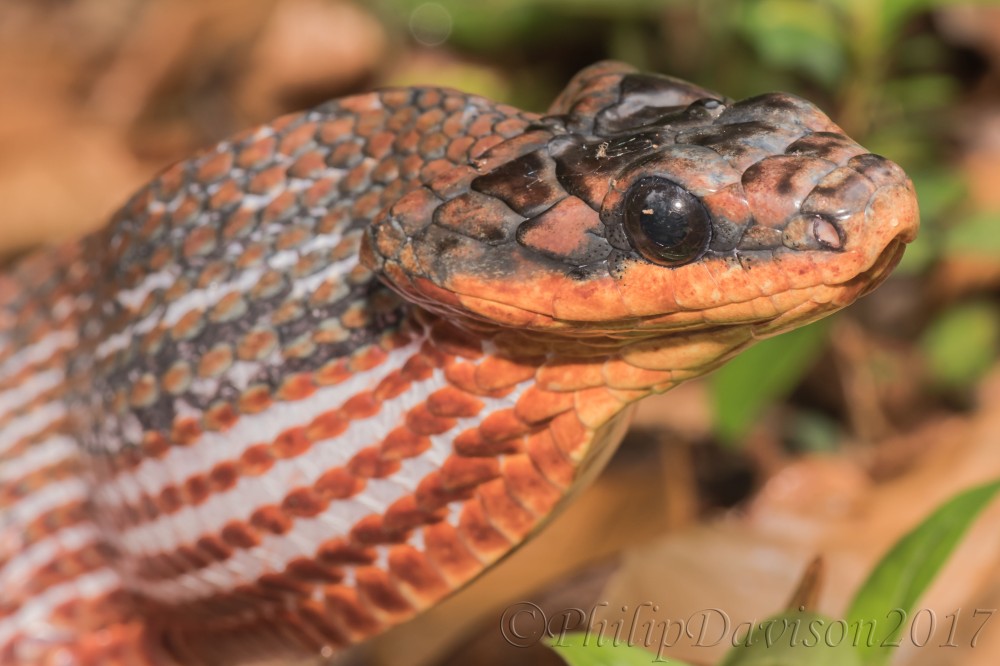
Defensive threat pose of a Tropical Bird-eating Snake
As I bent down to take a closer photograph, the snake duly obliged by living up to its name, flattening its neck, opening its mouth and letting out a hiss of discontent at my presence. I didn’t bother it for too long, took the pictures and left to let the serpent continue about its business.
Philip Davison Is a Biologist, Writer and Photographer Based in Costa Rica

Over the past week the rains have continued, now sometimes during the day as well as at night. The water level in the creek has risen, not drastically, but enough so that there is a steady flow. The mango orchard is the scene of a lot of activity with so many animals coming to feed from the bumper crop. During the day spider monkeys and white-faced capuchin monkeys can be seen greedily feasting on the abundant and ripening fruits. Monkeys are very wasteful feeders, they pluck a fruit from the branch, take a bite and throw the remainder to the ground. Here the white-nosed coatis and agoutis take advantage of a free meal falling from above.
At night the mangoes are visited by kinkajous in the trees and pacas on the ground, the nocturnal cousin of the agouti. All manner of insect life feeds on the fermenting mangoes, everything from flies, bees, butterflies and at night, moths.
Hopping Through The Grass
Grasshoppers are one of those creatures that tend to be a subject for more specialist study. Walking around the gardened areas of the lodge, particularly if it is a hot and sunny day, the disturbance of the longer and more dense vegetation will cause a flurry of activity as various species of grasshopper do as their name suggests, and jump out of the way to safety, others have wings and fly. Once they land, as long as you approach slowly, then you will be able to observe them at close quarters.
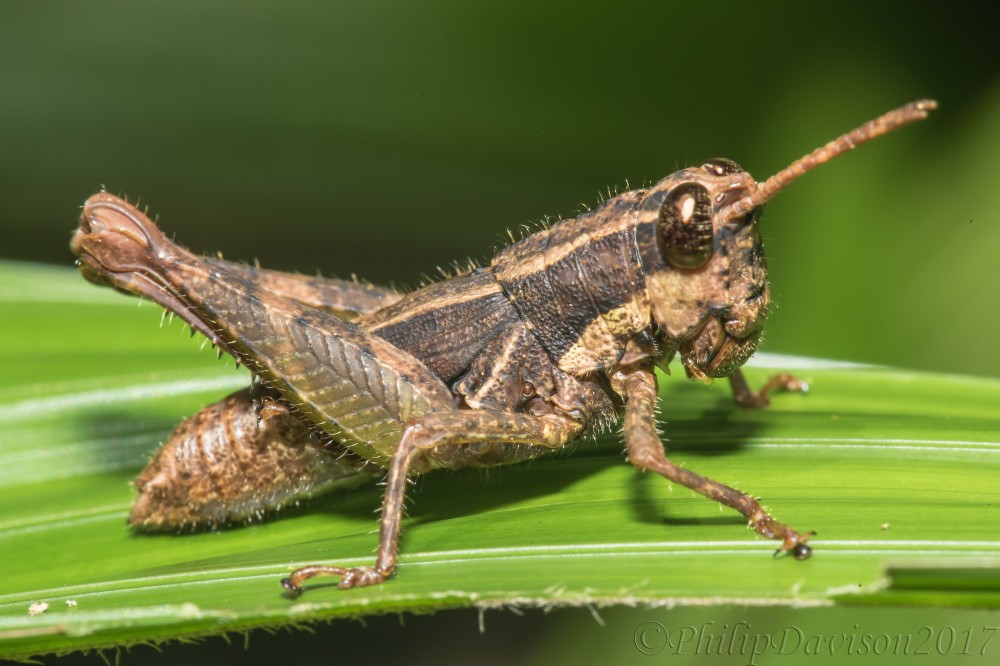
Unidentified Spurthroated Grasshopper species
The order: Orthoptera is an ancient order of insects and it is divided into two groups, the long-horned orthoptera which includes the crickets and katydids and the short-horned orthoptera which includes the grasshoppers. The horns referred to in the name are the antennae which in the grasshoppers are distinctively short and stubby. The majority of grasshoppers belong in the family: Acrididae.
Most people will be familiar with grasshoppers and the way they look. If it is a still, windless day then you will hear the male grasshoppers “singing” to attract a female. The sound is generally produced by stridulation or the rubbing of part of the hind leg on the forewing. If they are communicating with sound then they need receptor organs to hear it and the ears of a grasshopper are located on the first abdominal segment. The calls may also serve to keep rival males at a distance from one another.
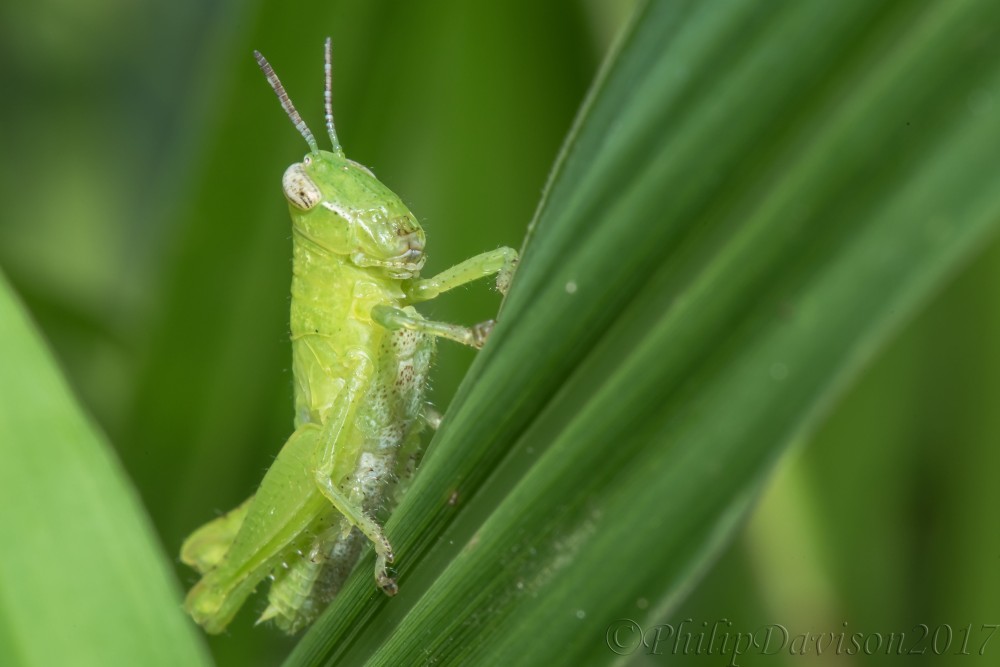
Unidentified Spurthroated Grasshopper sp. The perfect color of grass.
The majority of grasshoppers live in grassland but there are a few species that inhabit the forest and those prefer the upper levels of the canopy layer. Grasshoppers are almost without exception herbivores. In turn grasshoppers, because of their abundance and the fact that they are up to 75% crude protein, provide a large dietary percentage a many mammals, birds and reptiles.
Due to the lack of reference material it is very difficult to identify the grasshoppers to species level. The two that I photographed this week both belong to the subfamily: Cyrtacanthacrinae or Spurthroated Grasshoppers which are named for a small ventral spur between the front legs and which also includes the locusts.
Papering the Leaves
It does not require too much effort to seek and find the nests of paper wasps at the moment. All around the grounds the nests which are grey, globular parchment-like structures can be found hanging beneath the leaves of various plants. Some are small, some are large, some have the brood cells enclosed within a skin while others have the cells open.
I was watching butterflies flitting around the Lantana bush last week when I noticed this wasp on a leaf busying itself with something. Not having a hand lens with me I could not see what the wasp was investigating. Sometimes wasps are as difficult as butterflies to photograph. They will not remain still but this one seemed to be preoccupied and not going anywhere. I took the photograph but even after zooming in on the image was not entirely certain as to what the object was.
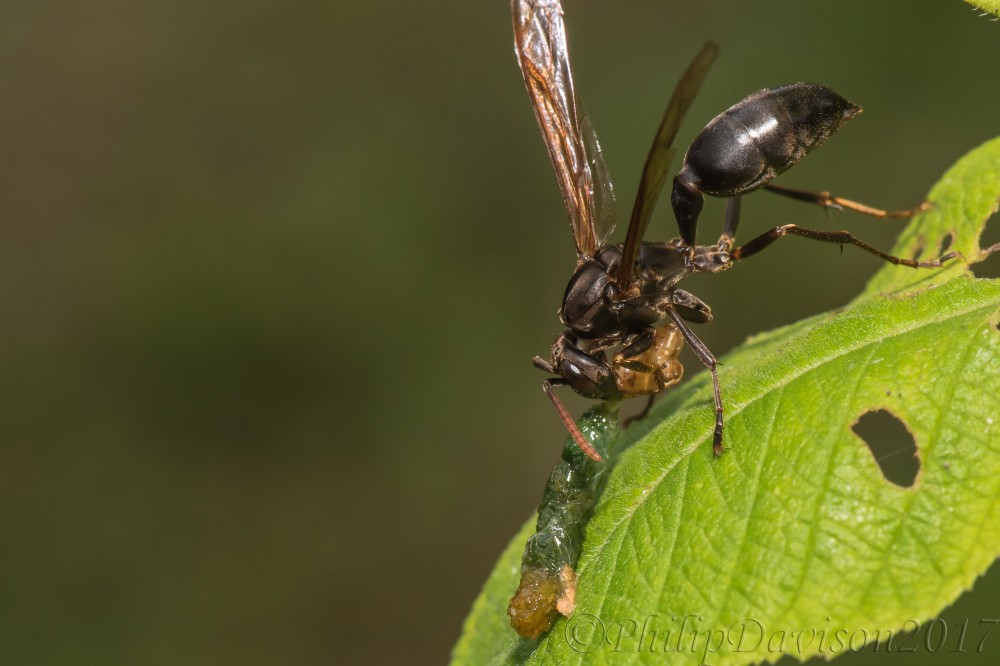
Long-waisted Wasp, (Myschocittarus sp), investigating mystery object
The wasp itself was one of the social wasps in the family: Vespidae and this one a Long-waisted Paper Wasp of the subfamily: Polistinae. The genus Mischocyttarus includes about 186 species and is therefore the most numerous of the paper wasps. The female Long-waisted Paper Wasps make a nest suspended by one or more stalks that she anoints with an ant repellant secretion she produces from a gland. The stalks secure anywhere up to 100 brood cells beneath a leaf. There is generally only one founding queen, (haplometrosis). When the new workers emerge from the cells, they help with the care of young developing in the brood cells. Eventually one of these subordinate female workers make take over dominance and drive the existing queen off.
The adult wasps catch prey and chew it up to feed the larvae as well as chewing up vegetative material to make the nest. In this case it looked like it was quite possibly a caterpillar that had been caught as there seemed to be leaf material within an enclosing integument. If anyone could shed any light on the object I would be happy to hear their opinion.
Backstabbing Bug,
While walking through the forest I noticed a small creature stumbling awkwardly across the forest floor. Sinking to my knees I could see it was an Assassin Bug. These are true bugs in the order: Hemiptera. Because they possess uneven wings they belong in the suborder: Heteroptera. The Assassin bug are placed in the family: Reduviidae.
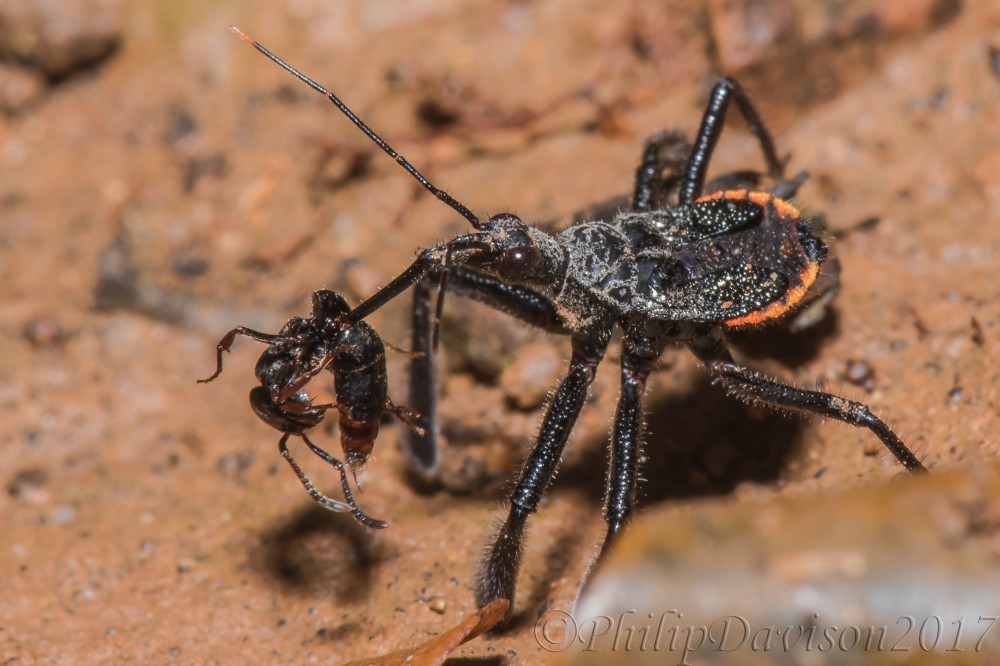
Assassin Bug with the corpse of a beetle
All Assassin bugs, as is indicated by their name, are fiercely predaceous carnivores. If you look closely at the photograph you will see protruding from the front of the head is the main weapon of death, a long, segmented beak that is normally held beneath the head and thorax until a victim is spotted that is. The assassin stabs the dagger-like beak into the prey, piercing the exoskeleton and delving deep into the tissues. The prey is held tight in the bug’s front legs while at the same time saliva is injected into its body. The saliva paralyzes the victim and digests its internal organs which are liquidized and then sucked out leaving only a dry and drained husk. Closer examination revealed the reason for the bugs ungainly gait across the ground, it was still carrying on its beak the now emptied body of a beetle.
Turkey Tail Perhaps
Sometimes there may be no other reason for photographing a subject other than its aesthetic appeal. That was why I photographed this bowl-shaped fungal fruiting body with the concentric bands of color, I just found it pleasing to my eye. I think this one is one of the Trametes sp. Due to the banding these are commonly called Turkey Tail Fungi. There are approximately 50 species in the genus and they are distributed globally throughout forest habitats.

Beautiful bowl-shaped Trametes fungus
Philip Davison Is a Biologist, Writer and Photographer Based in Costa Rica

Over the past week the weather has been consistent with that expected this time of year on the Osa Peninsula, Costa Rica. The days have, for the most part, been bright and sunny and then as the sun sets the rain begins. Normally there are heavy showers of short duration but occasionally they will be accompanied by thunder and lightning. Last week there was 7 inches, (178 mm), of rain, so an average of 1 inch per night. This has resulted in an elevated level in the creek which has started flowing once more after drying up for several weeks.
Now is an excellent time to see the amphibians as they are out in force at the moment. Every evening by the pond the sound of the calling males begins as the sun sets and the sky turns dark. The noise level rises over the next few hours until after dinner when it has diminished once more.
Currently there are a lot of parrots visiting the fruiting trees around the grounds, particularly Orange-chinned Parakeets, Mealy Amazons, Red-lored Amazons and their larger brighter cousins, the Scarlet Macaws. It is also possible to see the Brown-headed and White-crowned Parrots in the trees around the restaurant. The Black-mandibled Toucans and Fiery-billed Aracaris are present in reasonably large numbers and like the parrots are very vocal. Many of the palm trees are currently producing fruit and this feast is attracting these long-billed fruit-eating birds. It also gives photographers an opportunity to obtain some excellent close-range images.
Who Are You Looking At
Rainforests of the Osa Peninsula, Costa Rica are simply teeming with life. The first-time visitor will have no problem observing mammals such as monkeys, coatis and agoutis. With a little bit of perseverance Brown-throated Three-toed Sloths can be seen moving slowly through the tops of the trees. There are some mammals that are here but are not seen as often such as Collared Peccaries, Tayras, Pacas, Pumas, Ocelots, Striped Hog-nosed Skunks, Nine-banded Armadillos and Tamanduas.
I normally see the Tamanduas, (Tamandua mexicana), or Collared Anteaters, on video, when, at night, they trundle past the trail cameras located on the forest paths. Occasionally one will wander past as I am walking the trails or I may hear the sound of ripping wood along with the associated falling wood chips as one tears into a dead tree looking for a meal of termites. Last week however, I had an individual emerge from the tall grass in front of me and cross the gravel path that runs through the teak plantation.
Tamanduas are not the most aware of creatures, their sensory apparatus appears to fail them. If you are standing still or even walking slowly and silently, they will have no idea as to the proximity of your presence. Even if they do detect there is something close to them, they are still not entirely sure of what it is. As this one was moving quite quickly, (for a Tamandua), I lifted the camera and took the picture. As the flash went off the dim-witted creature was alerted to what might pose an immediate threat.
For a cerebrally-challenged and relatively slow-moving creature the options of escape are now limited. Out in the open the choice is not between flight or fight but rather just fight. The sudden flash of light and movement to its side caused the Tamandua to assume the defense stance. It stood upright on its back legs and opened its arms wide, wielding a set of razor-sharp claws in front of it. What was an innocuous, comical and cuddly-looking creature has turned instantly from a termite-eating Dr Jekyll into a dangerous Mr Hyde, adversary warning me to stay out of range or face the consequences of the potentially fatal embrace of death. Those claws could tear a hole in your windpipe within the blink of an eye. There are many stories, some apocryphal, of killer predators that have, in a twist of circumstances, become the killed in a fight with an anteater.
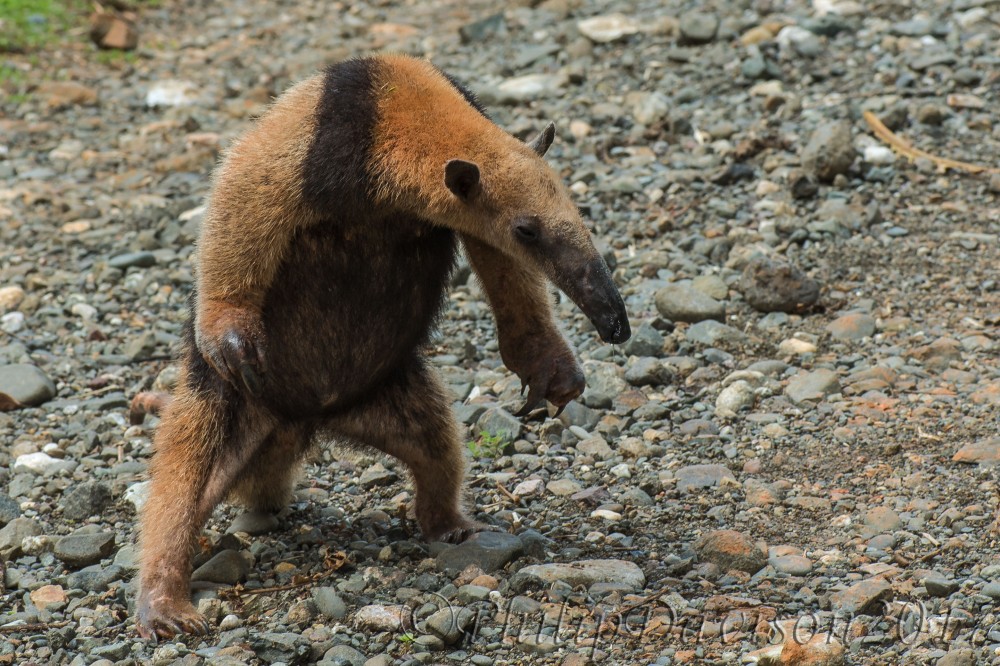
Northern Tamandua, (Tamandua mexicana) prepares to defend itself
This one huffed, puffed and wheezed its objection to my taking its picture. Everytime the flash went off its arms opened wider. Drool was dribbling from its mouth. I noticed that the longest claw from the left hand was missing but that was not going to deter it from making a slashing defense of its life. I got my pictures and backed away. The Tamandua sunk to all fours again and trundled off into the undergrowth probably forgetting the encounter ever took place even before it had made it into the denser vegetation.
The anteaters belong to an ancient mammalian order: Xenathra which also includes armadillos and sloths. This order is entirely confined to Central and South America. Tamanduas are placed in the family: Myrmecophagidae, literally translated as anteaters. The anteaters are toothless and use a long sticky tongue to scoop up their diet which consists mostly of termites but sometimes ants. Tamanduas are both diurnal and nocturnal but the activity is larger a matter of preference for each individual.
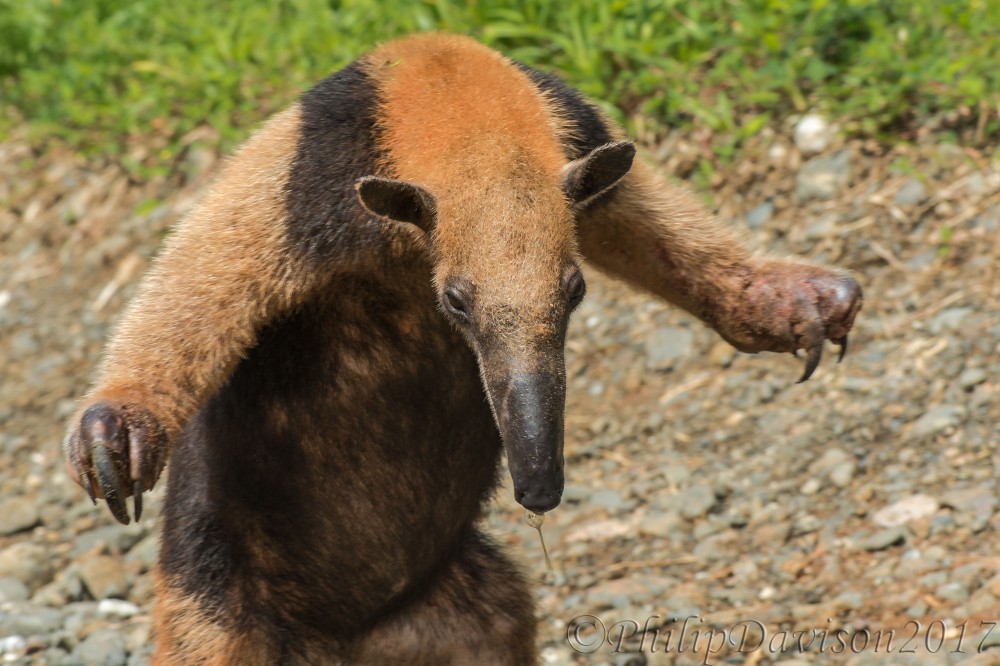
Northern Tamandua in full threat display. Watch out for those claws.
Tamanduas are adept climbers and will shimmy quite quickly up a tree in search of a termite nest. Having found one, they use those long sharp claws to rip a hole in the nest. The elongated skull terminates in a mouth which is little more than a hole through which the 16 inch long tongue is protruded. The tongue is coated in a sticky saliva. The anteater takes a quick feed and then makes a hasty retreat. Within the termite nest is a caste of soldiers that will defend the nest to the death, either physically or using chemical weaponry. The anteater will travel in a straight line through the forest visiting several nests during the course of the day, each time it takes a quick feed and then returns to its journey. This strategy is known as traplining and it allows the anteater to keep a food supply continually in production rather than go in and destroy that food supply. The anteaters will be found tearing the bark from rotten trees in search of termites as here there will only be harmless workers not accompanied by the defending soldiers.
When you come to Costa Rica and you are walking through the forest, don’t just pay attention to the vocalizations of mammals or the calls of different birds but also listen to other clues as to what might be near you. If it is ripping wood and falling wood chips there will be a good chance a Tamandua is sating its hunger in a tree above your head.
Praying For A Meal
It is not an uncommon situation for me to be passing a tree and notice on the trunk a small praying mantis. Should I approach and appear to be paying too much attention to the creature then it will run up and around the back of the trunk, out of sight, to escape further scrutiny. Last week I encountered an individual that obliged me by remaining stationary.
Mantids are carnivores, voracious carnivores. They feed mostly on insects smaller than themselves and to obtain their dietary intake of unfortunate victims they lie in wait; they are ambush predators. Many mantids have cryptic markings and use mottled coloration to camouflage themselves against the background. Some have evolved shapes and colors so closely mimicking leaves that they are rendered invisible within the vegetation where they are lurking in expectant anticipation of a passing meal.
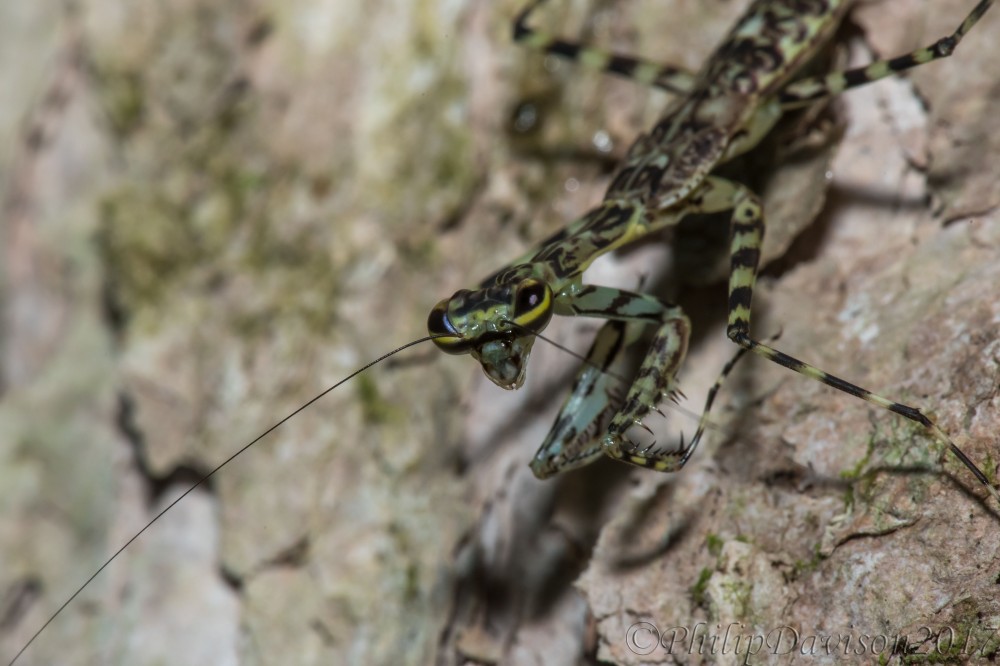
Tropical Bark Mantid, (Litergusa sp). Who is looking at who?
Because there they are so distinctive in their appearance, there is no mistaking a praying mantis when you see one. They sit with the head-end of the body raised up. The front legs are folded beneath the body and it is this posture that gives them the aspect as of someone in prayer, hence the name ‘praying mantis’. Don’t be fooled, those front legs are deadly killing weapons. The femur is large and lined beneath with wicked-looking sharp spines. The tibia too has its undersurface lined with spines. When a victim passes by the mantids reaction is both lightning fast and terminal. The selected prey is caught and impaled on the spines that come together in a powerful death grip. They not only hold but also impale the prey’s exoskeleton. The carnivorous mandibles set to work, rapidly rendering the meal into small consumable pieces. Within a short space of time it has been eaten and its existence committed to the past.
Mantids are closely related to cockroaches but form a separate order: Mantodea. There are about 300 species of mantid in the Neotropics. The one I was looking at was a Bark Mantid, (Liturgusa sp). It is one of the commoner species found in this area. Another regularly encountered species that immediately captures your attention is the Leaf Mantid, (Choeradodis rhombicollis). With its expanded prothorax and wide flattened wings, both of which are bright green, it looks exactly like a living leaf. The Leaf Mantis often finds its way into the restaurant at night, landing by the lights that illuminate the table of the dining guests.
Mantids make such compelling photographic subjects as they quite often sit still but the head will follow in whichever direction you move. The structure of eye and the way that light enters it gives the impression, albeit a false one, that it has a pupil. These along with the large triangular head, lend an almost humanoid aspect to the insect.
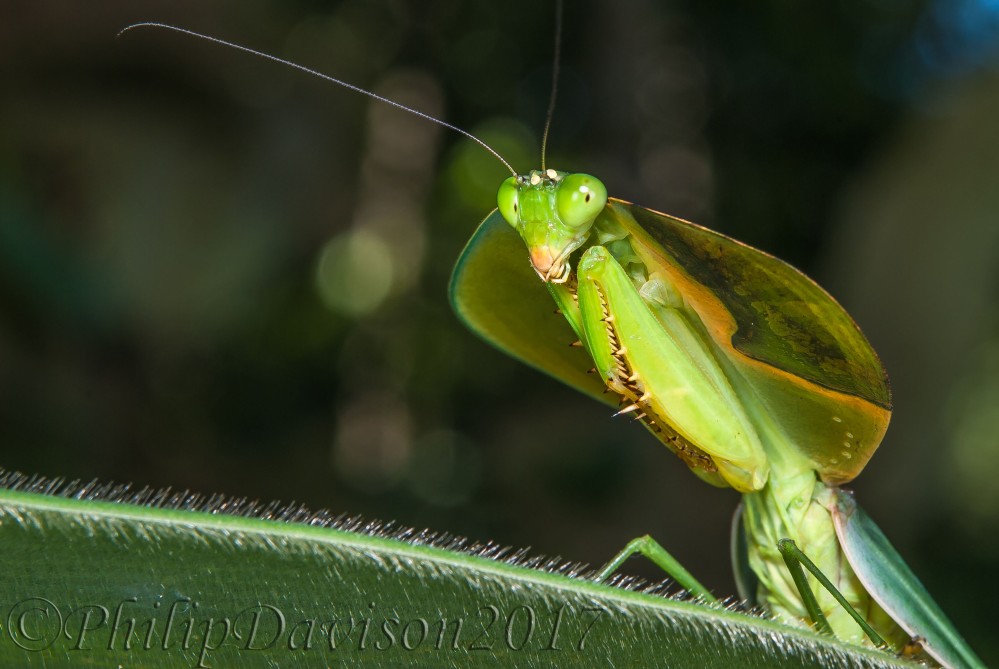
Leaf Mantis, (Choeradodis rhombicollis), in a perfect pose
Naked and Exposed
There is one animal that for a long time I have had on my list as a subject I needed to have an image of. It is a reasonably common animal and I see it more often than not when I am walking on the forest trails. I always think to myself that I should take a photograph. The animal in question is a small lizard that lives down on the forest floor amongst the leaf litter. If disturbed it moves in a labored serpentine squiggly fashion across the bare earth until it reaches the safety of the dead leaves covering the ground and then it disappears beneath. I saw this one do exactly that but the leaf under which it took refuge was isolated with nothing else around it, there was nowhere else for the lizard to go. I prepared the camera, knelt down and slowly lifted the leaf. There it was. It remained perfectly still allowing me to take a series of photos until eventually it squiggled off to reach the safety of a denser covering of leaves.
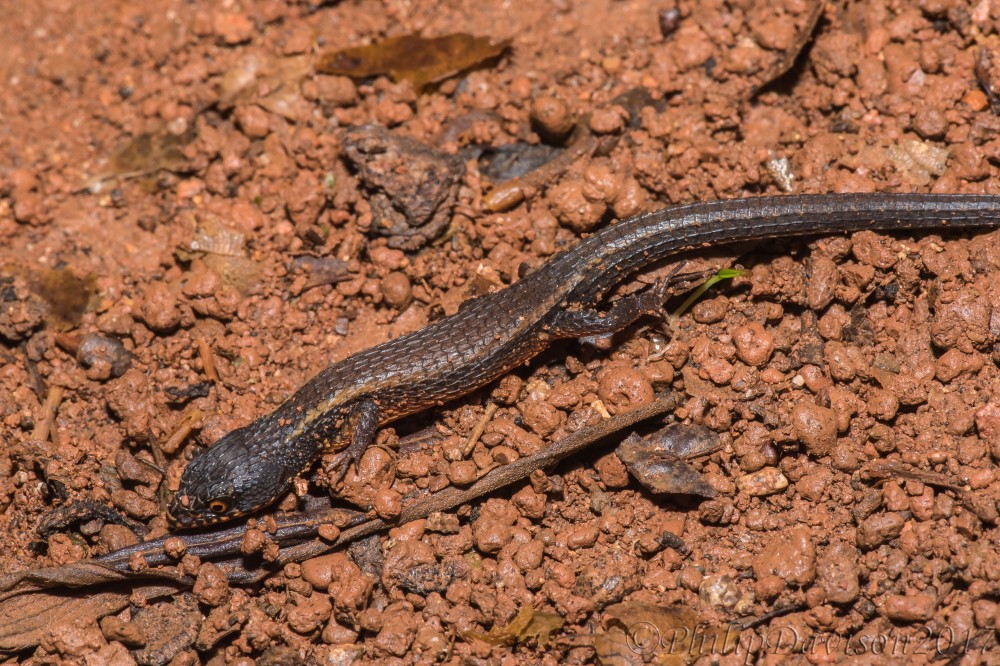
Northern Spectacled Lizard, (Leposoma southi), briefly exposed from its hiding place
This particular lizard was a Northern Spectacled lizard, (Leposoma southi). There are only 13 species in the genus Leposoma. They range from Costa Rica south into Brazil. They are small and inhabit the leaf litter on the forest floor where they feed on insects and other small arthropods. When seen from a distance they have a dull brown coloration with a matt lustre. Scrutinized more closely you will see a very distinctive feature, the prominent keeled scales particularly those plates covering the head. There is another small lizard that inhabits the same habitat and moves in a very similar fashion, the Litter Skink, (Sphenomorphus cherriei). It is easy to tell them apart as the skink has very glossy smooth scales giving it the appearance of polished bronze. That is another creature I need to take a photo of.
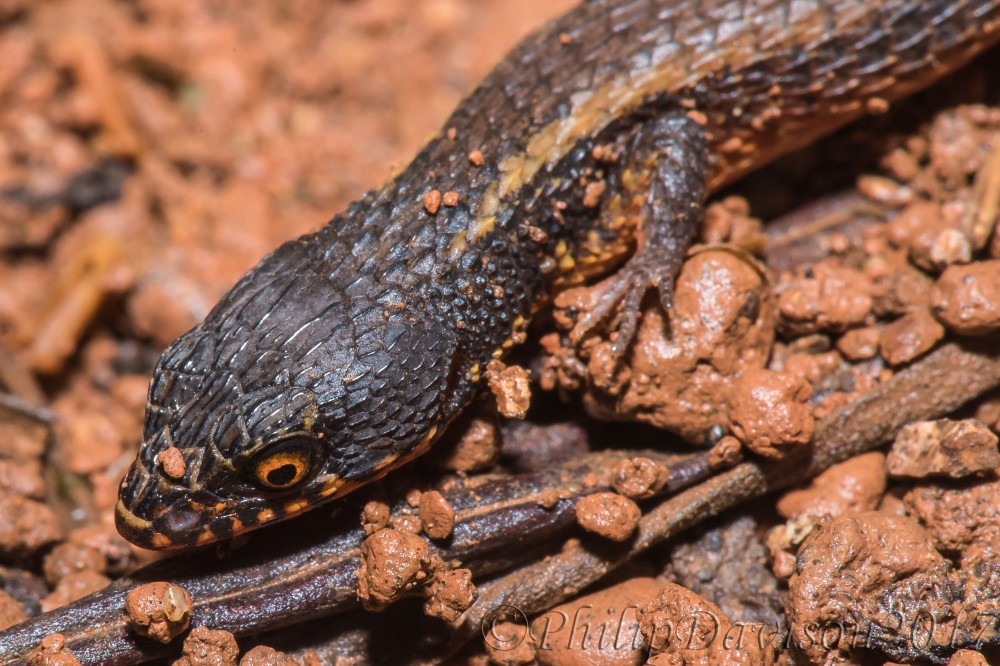
Northern Spectacled Lizard – close up showing heavily keeled head plates
Philip Davison Is a Biologist, Writer and Photographer Based in Costa Rica

Long-horned Heavyweights
Beetles and bugs are two groups of insects that can be both fascinating and frustrating at one and he same time. There are so many of them in terms of species and they come is so many varieties of shape and color that it really does take an expert to identify them and even then they may find themselves sorely taxed to do so.
I am always happy if I can manage to identify a beetle to species level, bugs are not so hard until you get to the individual species. I tend, therefore, to enjoy them for what they are, interesting subjects to photograph. Once I have posted the photograph into the public domain if someone can kindly offer up a name I am always grateful.
This beetle was found by my cabin one day last week. I did not think it would stay to have its picture take but fortunately it duly obliged. It was a quite a striking creature at over 2 inches long with bold markings of yellow bars on the ruddy-brown wing cases. The antennae were distinctive, being long, black and curved upwards and outwards.
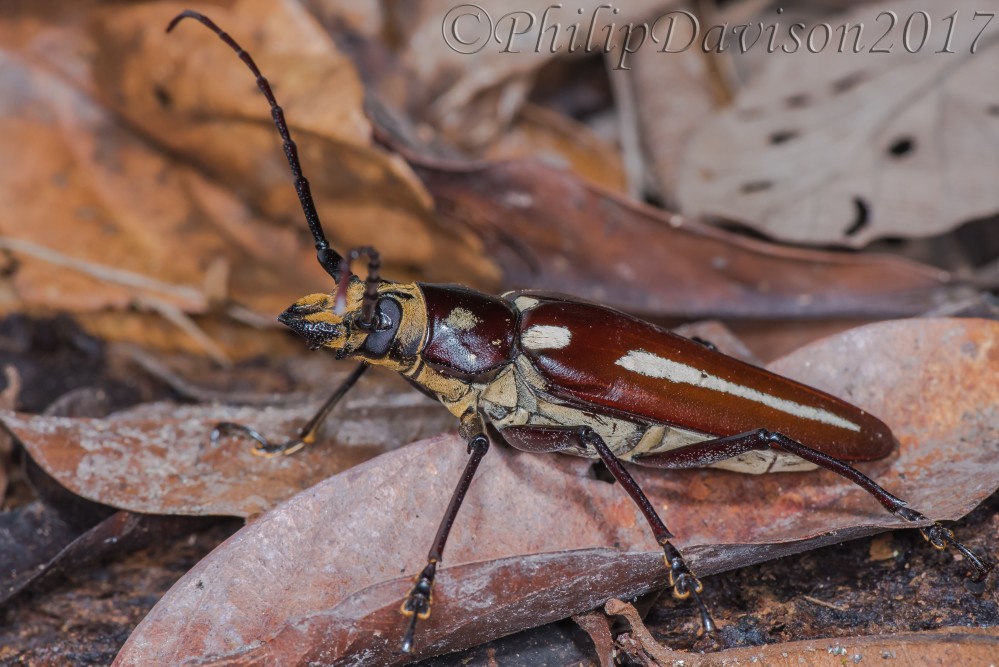
The Giant Brown Callipogon, (Callipogon lemoinei)
At approximately 320,000, the total number of beetle species on the planet is the equivalent of all known named species of plants. They constitute over 30% of all known animal life. In Panama alone, 11,410 species of beetle were found on 70 species of tree. So you get the idea that there are a lot of different species of beetle and that is just the named species. Beetles can be found in just about every habitat from forests, deserts and fresh water. The beetle I was looking at belonged to the family: Cerambycidae or long-horned beetles, (due to the length of the antennae), which is one of the larger families within the order: Coleoptera. There are 2,200 species of long-horns found in Costa Rica, (1,100 species in the U.S.A.). I knew it belonged to the Tooth-necked Long Horn subfamily: Prioninae. I even knew the species, the Giant Brown Callipogon, (Callipogon lemoinei).
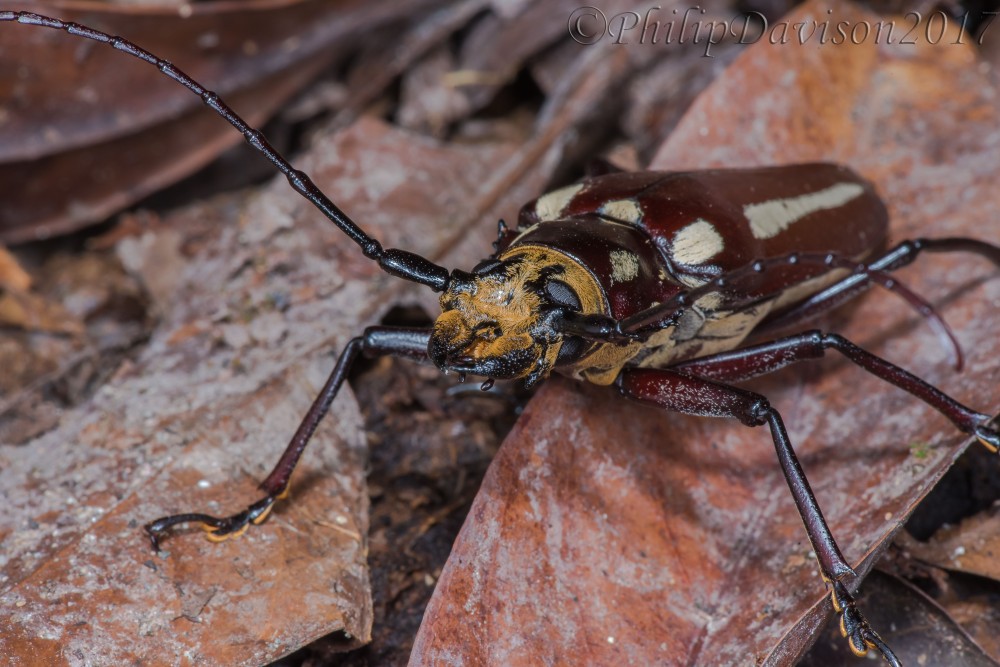
Look at the wood-munching mandibles of the Giant Brown Callipogon
Some long-horns do not eat in the adult stage but most do and those that do all feed on a variety of plant material. Those powerful and savage-looking mandibles will allow them to munch their way through the toughest material plants produce. They are the most important group of beetle pollinators and some of them can be seen visiting flowers where they consume both nectar and pollen. The larvae feed on dead wood and are a serious pest to the timber industry by damaging recently felled lumber before it reaches the saw mill.
The Prioninae males tend to have longer antennae than the females. They sit on leaves, antennae extended waiting to pick up a pheromone trail given off by a sexually receptive female. The females use the heavy-duty mandibles to chew the wood of a branch which kills the distal portion into which she will then deposit her eggs. Those people with exceptionally good ears can hear the branch being rendered dead from several meters away.
All in all I was happy not only to have found the beetle but also that I actually knew what this one was, (the odds are normally against me), and I managed to get some decent photographs.
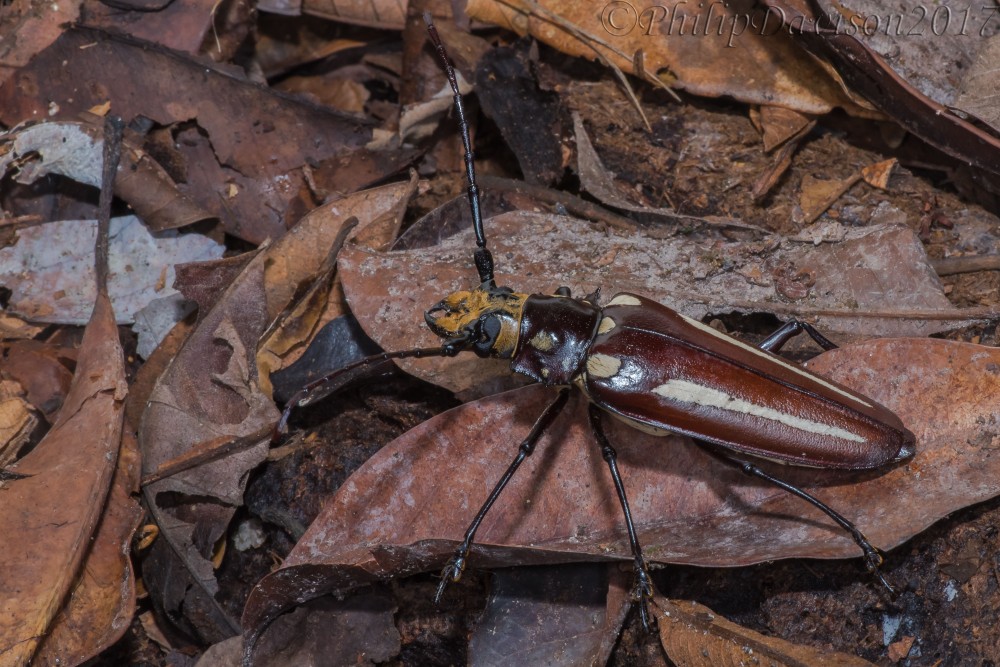
Giant Brown Callipogon male waiting to pick up the scent of a female
Bugged by Bees
The cashews, (Anacardium occidentale), have all but finished fruiting. There are one or two cashew apples left hanging from the branches with their distinctive fruits suspended beneath them. As I walked past one of the smaller cashew trees I noticed a bug sitting amongst the leaves. While not being anywhere near as diverse in numbers as the beetles, the true bugs of the order: Hemiptera are every bit as diverse in form.
This one belonged to the suborder: heteroptera, as was evidenced by the divided wing, papery at the end and solid at the base. This one also had a diagnostically distinctive feature in that the rear pair of legs were flattened and expanded leaving you in no doubt that it belonged to the family: Coreidae, commonly known as the squash bugs or leaf-legged bugs. A few of the squash bugs are predatory carnivores but most of them are herbivores. The mouthparts are modified into a long piercing proboscis which is held along the underside of the head and is used to suck sap from the vascular system of plants.
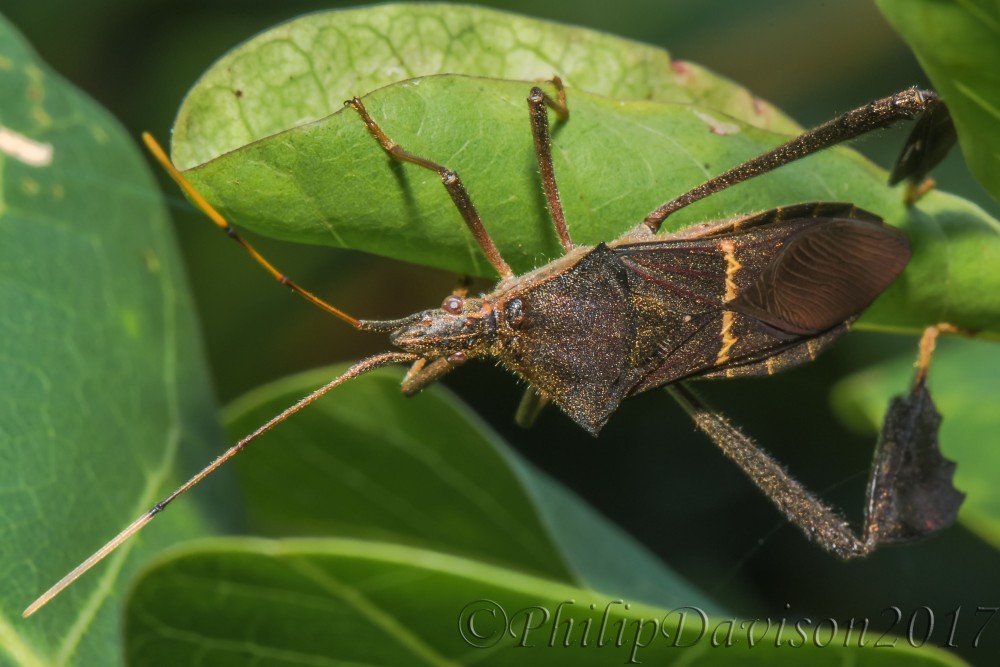
Leaf-legged Bug, (Leptoglossus phyllopus), found in a cashew tree
The bug was not the only imbiber of cashew juice. On one of the fruits, the swollen meristem or cashew apple, had been damaged and the soft tissue was attracting a small group of stingless bees, (Trigona sp). Before the introduction of the honey bee, (Apis mellifera), from Europe the main source of honey in the New World was that produced by the stingless bees. The bees nest in cavities within hollow trees. The nests can be recognized not only by the presence of the bees themselves but also the entrance to the hidden nest has a long resinous tube sticking out horizontally.
As benign as stingless may sound these bees are not to be trifled with. Anyone approaching too close to the nest and being perceived as a threat is in for a nasty surprise. They attack an aggressor in numbers and they are committed to the defense of the nest. They fly furiously up the nose, into the ears, into the eyes and swarm into the hair all the time biting ferociously, some of them rubbing in a caustic secretion which burns. Little wonder that their Spanish name of Carafagos translates into Spitfires.
Thankfully the ones I was looking at were more concerned with enjoying their free cashew smoothie than my presence. Not even the flash from the camera elicited the slightest response.
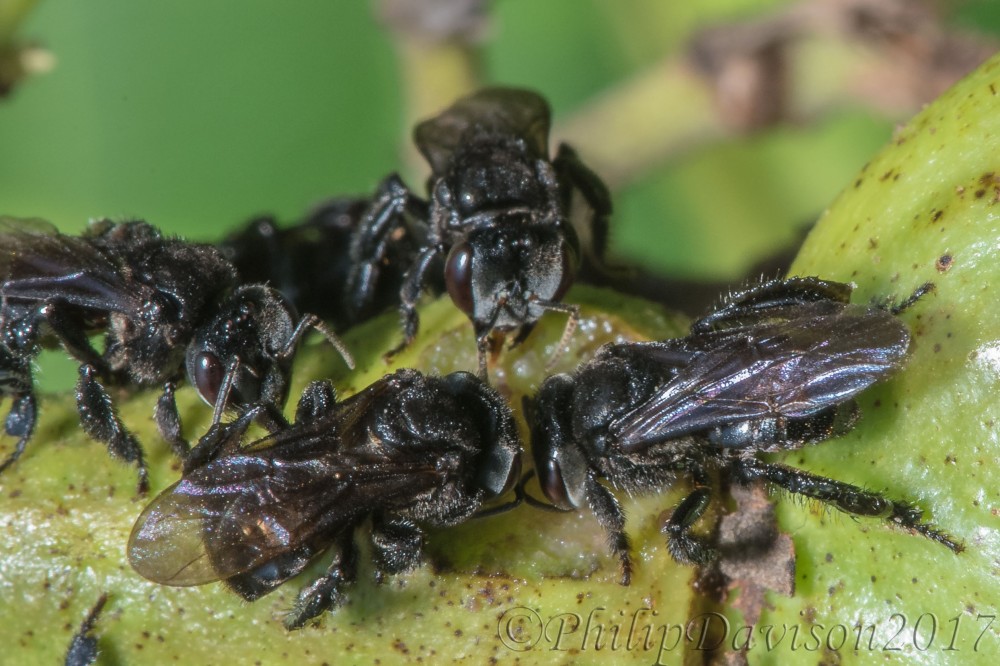
Little black Spitfires – Stingless Bees, (Trigona sp), drinking the juice of a cashew fruit
A Natural Mashup
Another one of the native Costas has come into bloom throughout the gardens and forests of the area over the past week. The wild ginger, (Costus laevis), is native to the wet forests of Central and South America and is the commonest of the costas in the wet forests of the Osa Peninsula.
It has a smaller flowering spike with green bracts from which the deep orange and purple striped, yellow-lipped flower emerges. The principal pollinator of Costus laevis are the females of the orchid bee, (Euglossa imperialis), which have a very long proboscis to probe deep into the flower. Should the bloom be visited by hummingbirds then pollination is not accomplished.
Costus laevis also has extra floral nectaries which provide a food source for a large variety of ant species. In return for a feed of nectar the ants protect the plant, probably from the attention of would be seed predators.
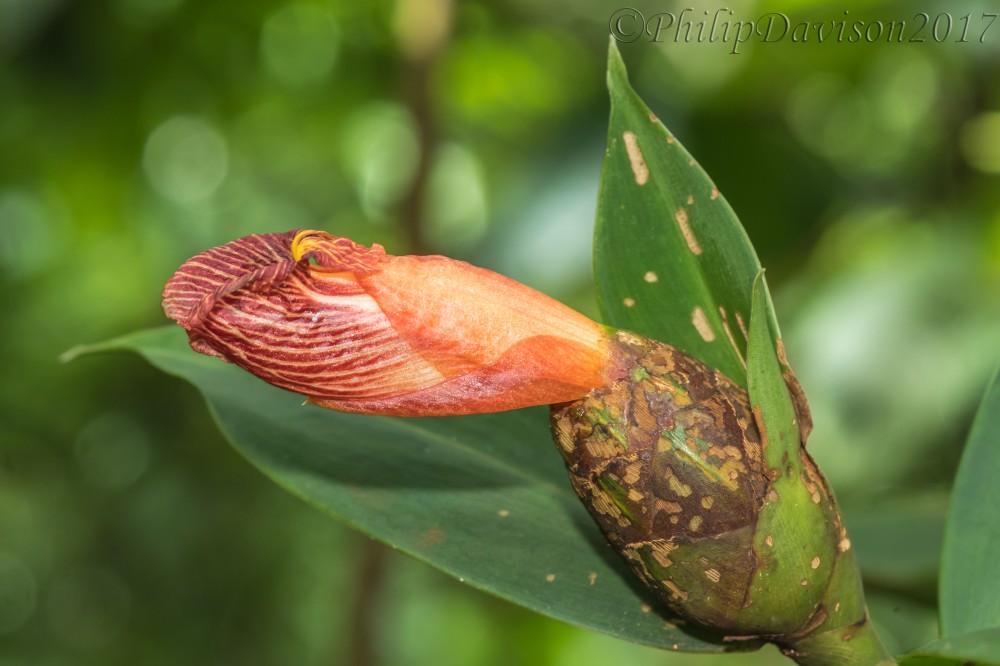
Native Wild Ginger, (Costus laevis), the bloom of which is pollinated by orchid bees
The damp conditions of the forest prevalent at this time of year allow the fungi to continually produce fruiting bodies. As I have mentioned in previous blogs, the identity of most fungi must remain a mystery, not unlike most beetles. But they can still be appreciated for their exotic shapes and color as well as their ephemeral presence.
One very short-lived mushroom is that of the Pleated Inkcap, (Parasola plicatilis). Early in the morning just before sunrise, the small white cap makes its way up out of the soil and through the grass. It opens into a miniature white umbrella and sheds its spores from gills on the undersurface into the air. Within a short space of time the job is done and the cap continues to evert until all that is left is a delicate translucent umbrella that has almost been turned inside out.
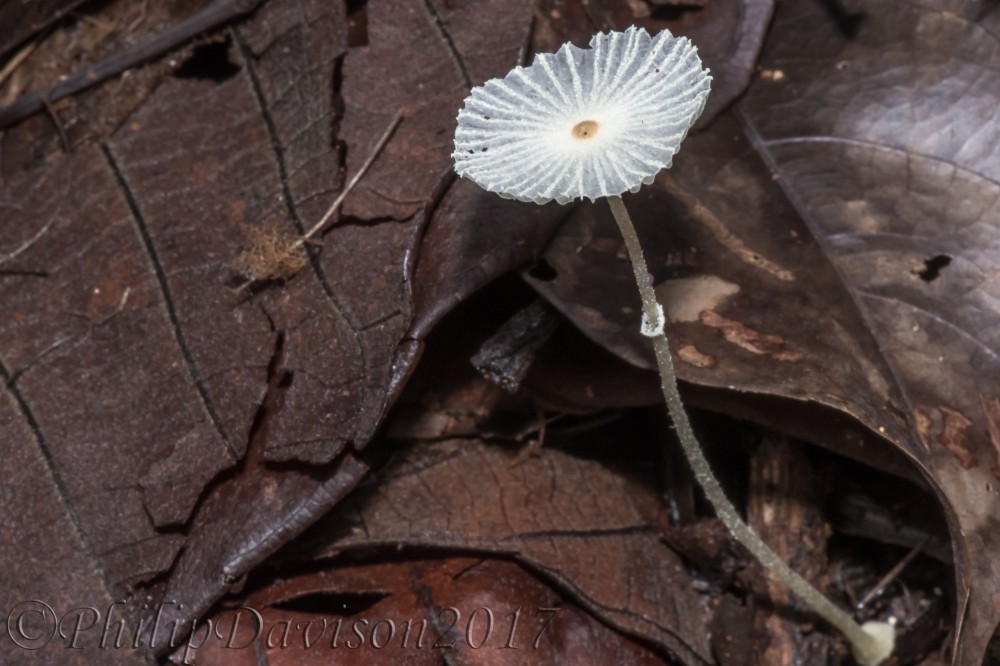
The delicate and spent mushroom of the Pleated Inkcap, (Parasola plicatilis)
There is no mistaking the very distinctive form of the literally described Orange-cup Fungus, (Cookeina speciosa). Like small flame-colored goblets set on the forest floor for a faerie revel they stand out against the dead wood on which the mycelium is growing. Unlike the inkcap, the Orange-cup Fungus produces its spores from the surface of the cup lining. This time of year the forest floor is decorated throughout by these compelling little structures.
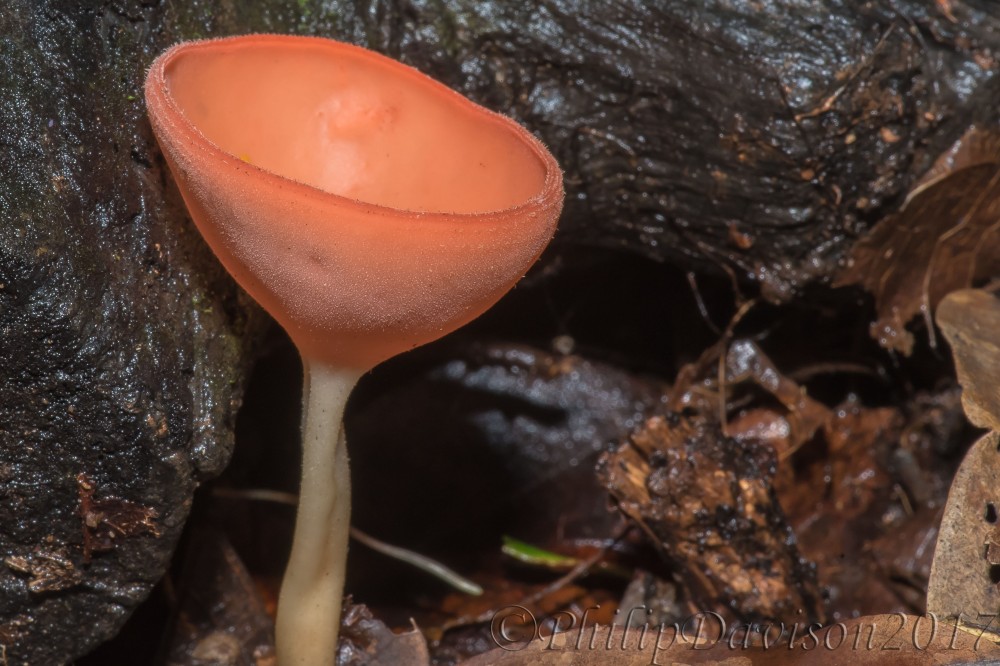
The unmistakable and literally described fruiting body of the Orange-cup Fungus, (Cookeina speciosa)
Another bright orange fungus found growing on dead wood but this time in the form of semi-circular brackets is the Beauty Fungus, (Hymenochaete luteo-badia). The vibrant orange striped shelf is bordered by a vivid yellow edging. The spores are produced in pores on the ventral surface.
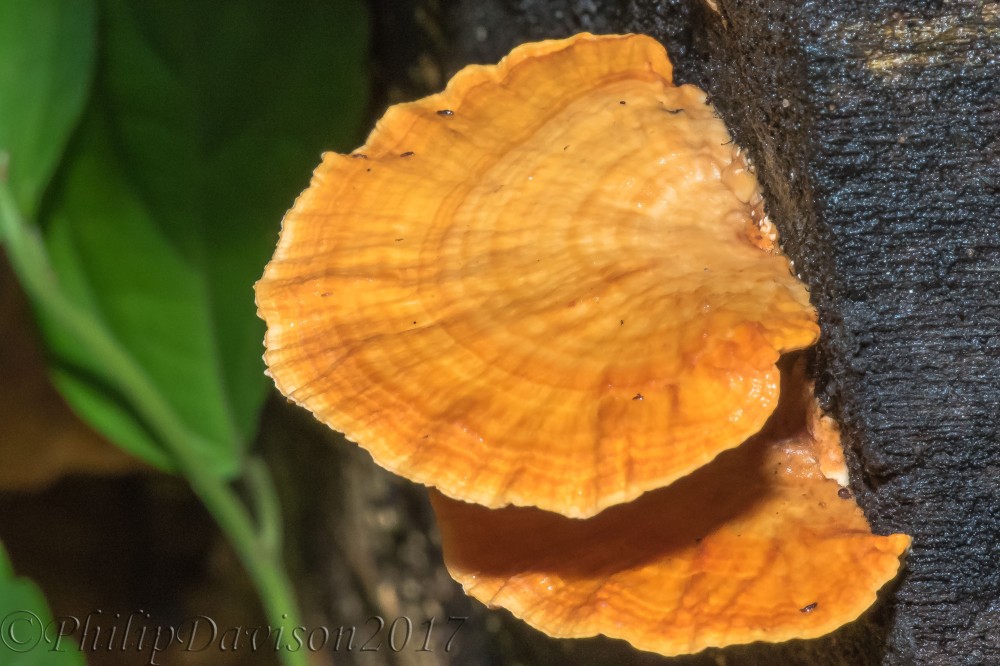
Beauty Fungus, (Hymenochaete luteo-badia)
Philip Davison Is a Biologist, Writer and Photographer Based in Costa Rica

Sticking to the Twigs
There are some animals that live out in the open, right in front of your eyes, and yet you never see them. That is because they don’t want to be seen. Only when mistakenly they venture forth onto a background that reveals their presence will you have the opportunity to marvel at their disguises. One such group of animals are the Phasmatodea, more commonly known as Walking Sticks or Stick Insects.
Last week I saw one that had made such an error. It had left the vegetation where it lives perfectly concealed from view and had wandered onto the screen of my cabin. There it stood out like a sore thumb. Thankfully for the phasmid it was my eyes that saw it before those of any potential predator. If removed the unfortunate creature and placed it back amongst some twigs from which I could take its picture but also from where it could make its way back into the obscurity of the vegetation.
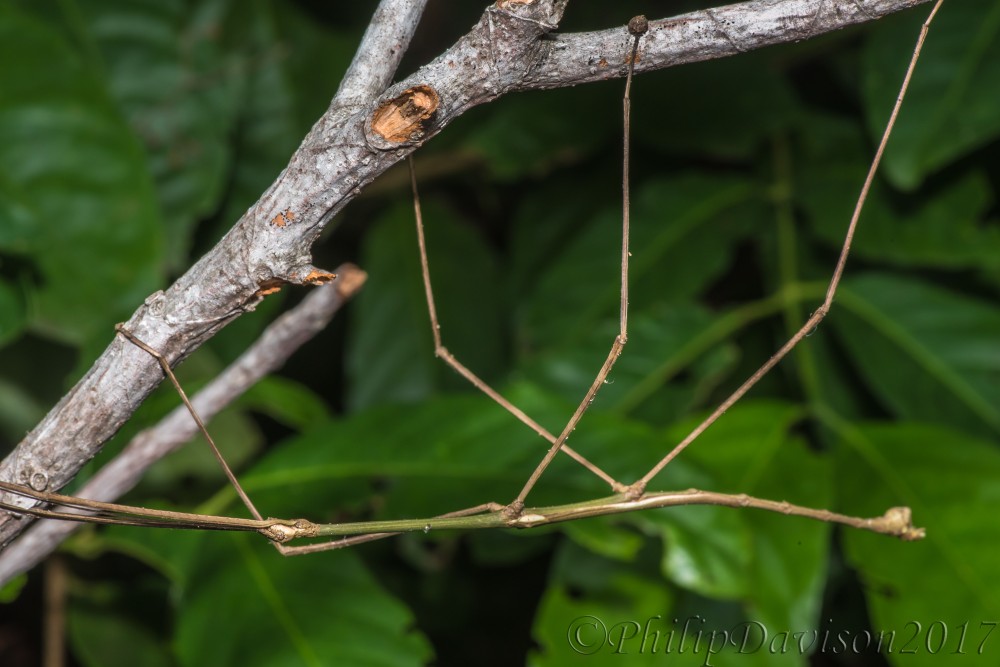
The long spindly legs and body of a Walking Stick make enable it to avoid the attention of predators
The body and legs of the walking stick are long and spindly. They are either green or brown in color and quite often, as this one was, a mixture of the two. The body and legs are grooved and have small thorns. They resemble so perfectly a twig that, even when you are looking directly at them, they are imperceptible. Some species have wings but not the one I was looking at. They are vegetarian and tend to be host specific. Walking sticks reach the zenith of their diversity in tropical forests such as these, of the 2,500 species identified so far, 30% live in the Neotropics.
As well as the perfectly camouflaged body form the phasmids use other means by which to complete the illusion. This one, when disturbed, would rock back and forth as a twig being blown in a breeze. Then it would freeze and hold the front legs as well as the long filamentous antennae out in front of its head to make to enhance its long twig-like form.
In and Out of the Rainbow
There has been a new wave of plant life that has come into bloom over the past week or so. The cycle of change in the forest is such that throughout the year you are never short of something new to see or hear each time you venture out onto one of the trails. As the flowers of certain species turn to fruit, then so do others come into bloom. The flowers and fruit provide a continual annual transition of color and form. You only have to keep your eyes open as you walk and you will be rewarded with a visual sensory feast.
Last week one of the most obvious additions to the floral display was the Recadito, (Palicourea guianensis) of the family: Rubiaceae. The multi-clustered bright yellow flowers are borne on a vivid red stalk at the end of the branches. They are visited a lot by butterflies, especially if found growing at the forest edge. It is a small tree with large leaves and is reasonably common in wet habitat from Mexico to Bolivia. There are 27 species of Palicourea to be found in Costa Rica, 3 of which occur on the Osa Peninsula.
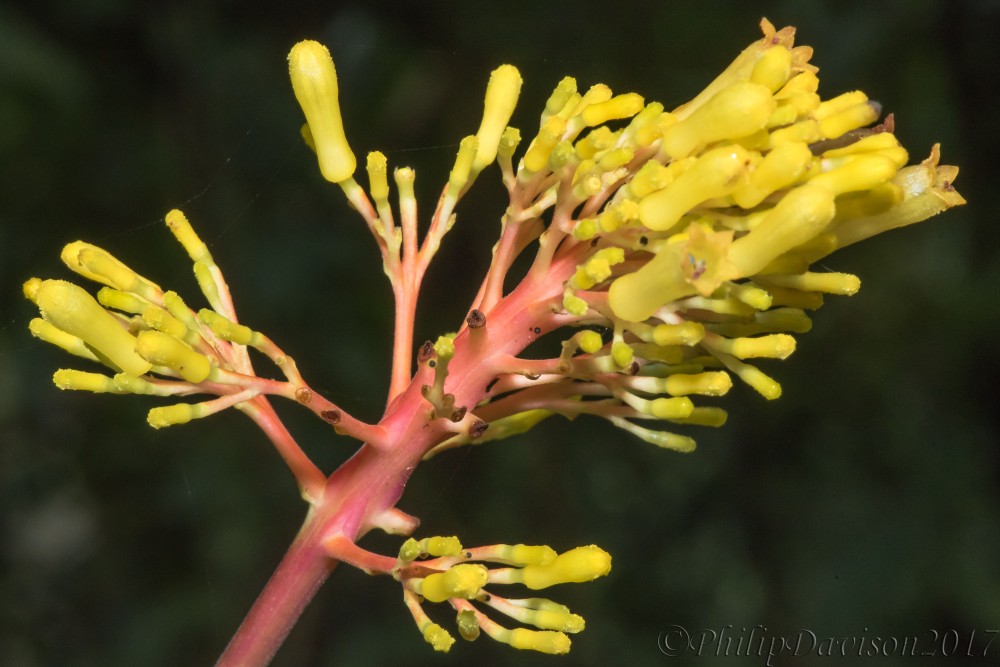
The distinctive floral display of Recadito, (Palicouria guianensis)
Another related plant, but much smaller and subtler is the Cafecito, (Psychotria capitata). It too, belongs in the family: Rubiaceae but it is a very large genus, 115 of which live in Costa Rica, 40 of those on the Osa Peninsula. They are not always easy to identify to species level. This one, Psychotria capitata has small white flowers which when pollinated give rise to small purple berries. At that point it resembles a rather swollen blackberry fruit.
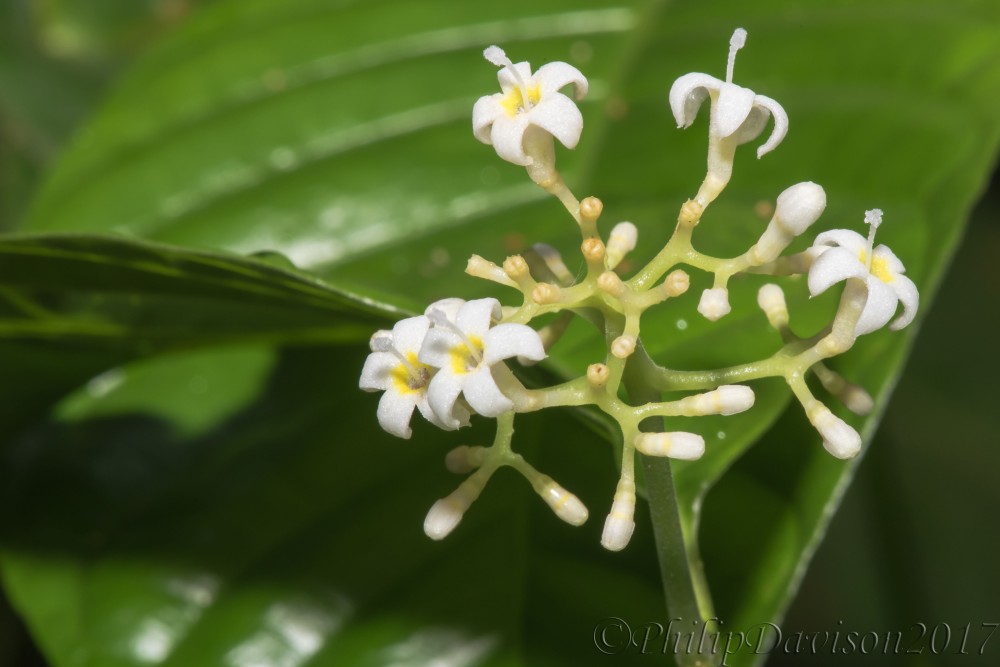
Delicate white flowers of the unobtrusive Cafecito, (Psychotria capitata)
Crosier for a Green Bishop
Ferns, or pteridophytes, are non-flowering vascular plants that most people who enjoy walking in the countryside will be familiar with. You will not see fruits or seeds as ferns produce tiny dust-like spores produced in special spore cases on the underside of the leaves. There are about 800 species of fern in Costa Rica but their form is so distinctive that they are not too difficult to recognize as such. They are mostly low growing in shady areas of the forest but there are some that grow to a substantial size, the tree ferns. These behemoths of the pteridophyte world, along with the cycads, were the dominant form of terrestrial vegetation before flowering plants evolved, and can be regarded as the “Food of the Dinosaurs”.
There are tree ferns found growing in these forests but they don’t reach the giant statures of those in other parts of the world. Most of the ferns here are of the low growing type. When a new leaf is produced it lies in the center of the plant, wound around itself like a green rope on a spool. As the days pass it unfurls up and outward, revealing leaves that appear as an organic fractal, repeating the pattern on a smaller and ever smaller basis. Eventually as the stalk has reached its maximum growth, the final part resembles a Bishop’s Crozier, which ultimately uncurls and the side-branching leaves and leaflets open out to reveal the familiar frond.
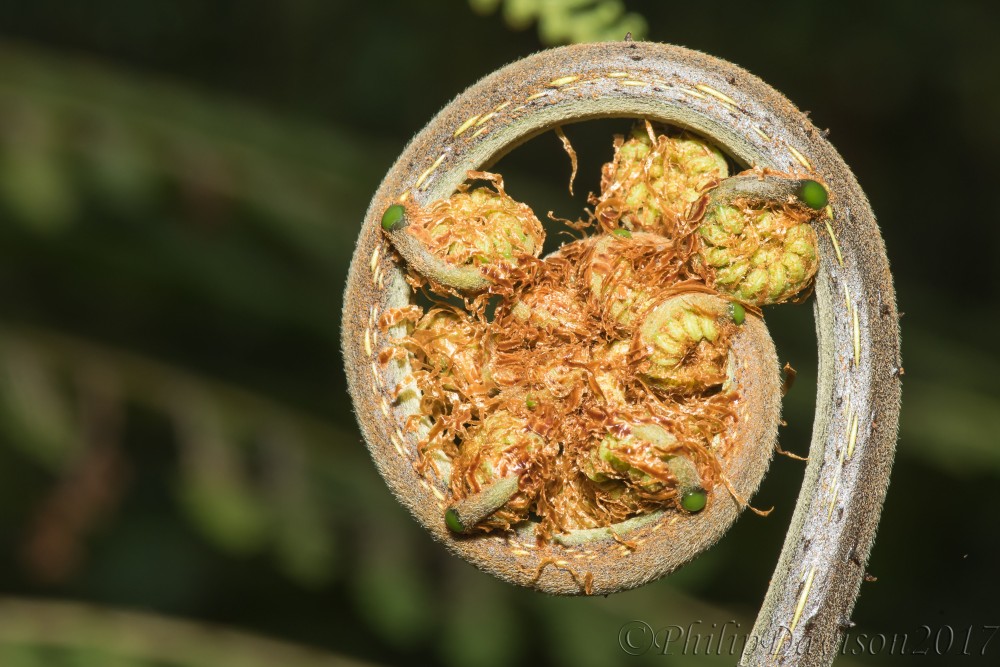
An unfurling fern frond
Mustachioed Murderer
Walking through the forest I entered a more open spot where the sun was lighting up a clearing. I noticed something move very quickly on the forest floor. It settled on the surface of a leaf. I knew what it was but to begin with I was a little puzzled as it looked to possess four large eyes, so in my mind I was looking at one insect perched on top of another. I bent down to take a closer look and I could now see my mistake. There were most certainly two very large distinctive eyes but the dark markings contrasting with the yellow ground color of the thorax gave it the appearance of a second insect sitting on its back. I could now also confirm my identification as that of a Robber Fly, family: Asilidae.
Robber flies are true flies of the order: Diptera and therefore only possess one pair of wings. A distinctive feature of the robber flies is the cluster of hairs at the front of the head that give them a look of an Edwardian gentleman sporting a rather luxurious mustache. This is known as a mystax, which is taken from the Greek word for mustache.
Why would a fly have a protective mustache of bristles protecting the front of the head? The Robber Flies are accomplished predators and will hunt down any arthropod of a suitable size, not too small, not too large, that makes the unfortunate mistake of entering into the killer’s field of view. The Robber Fly has large eyes and respond with speed to a potential meal. It uses the stiletto-like piercing mouthparts to stab its victim and to inject a saliva which contains a deadly cocktail of neurotoxins and cell destroying enzymes which render the prey to a corpse being digested from within. The fly then sucks out the pre-digested meal. They have no hesitation in attacking wasps and ants which themselves are capable of inflicting a fatal bite or sting. The mustache serves to protect the fly from such retribution.
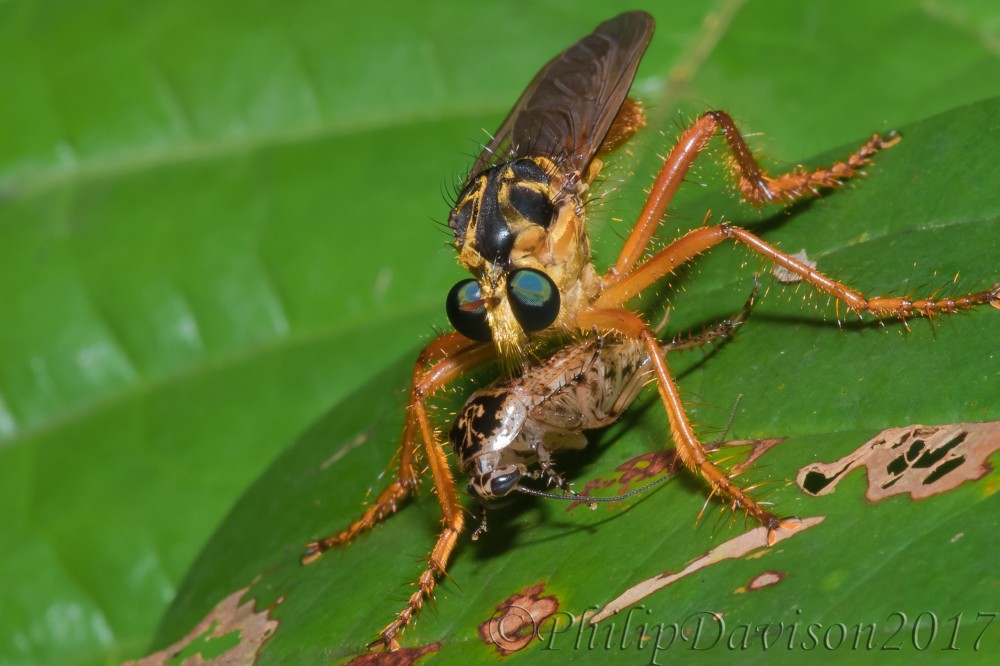
Assassin with stilleto ; Robber fly with cockroach prey
Robber Flies prefer sunny gaps in the forest, which is exactly where I found this one. They sit on a perch located low to the ground and wait for a meal to pass by. Their reaction speed is so fast that in a blur of the eye they can snatch a flying insect out of the air. You can see in the photograph that this one had just caught a tropical cockroach. Don’t try to catch one in your hand as a stab from that proboscis is very painful.
There are about 7,500 species of Robber Fly distributed around the planet, preferring warmer areas that are arid or receive only seasonal rainfall. They are not that hard to find, pick a sunny light gap and then you just have to sit and watch for that quick movement.
Philip Davison Is a Biologist, Writer and Photographer Based in Costa Rica

























































